12.1: Family
12.1.1: The Nature of a Family
In human context, a family is a group of people affiliated by consanguinity, affinity, or co-residence.
Learning Objective
Differentiate between conjugal family and consanguineal family
Key Points
- As a unit of socialization, the family is an object of analysis for sociologists, and is considered to be the agency of primary socialization.
- A conjugal family includes only the husband, wife, and unmarried children who are not of age. This is also referred to as a nuclear family.
- Consanguinity is defined as the property of belonging to the same kinship as another person.
- A matrilocal family consists of a mother and her children, independent of a father. This occurs in cases when the mother has the resources to independently rear children, or in societies where males are mobile and rarely at home.
- The model of the family triangle, husband-wife-children isolated from the outside, is also called the Oedipal model of the family and it is a form of patriarchal family.
- A matrilocal family consists of a mother and her children.
- The model, common in the western societies, of the family triangle, husband-wife-children isolated from the outside, is also called the Oedipal model of the family and it is a form of patriarchal family.
Key Terms
- consanguinity
-
a consanguineous or family relationship through parentage or descent; a blood relationship
- matrilocal
-
living with the family of the wife; uxorilocal
- A conjugal family
-
a family unit consisting of a father, mother, and unmarried children who are not adults
Example
- The marriage rate in 2005 (per 1,000) was 7.5, down from 7.8 the previous year.
Families
In human context, a family is a group of people affiliated by consanguinity, affinity, or co-residence. In most societies, it is the principal institution for the socialization of children. Occasionally, there emerge new concepts of family that break with traditional conceptions of family, or those that are transplanted via migration, but these beliefs do not always persist in new cultural space. As a unit of socialization, the family is the object of analysis for certain scholars. For sociologists, the family is considered to be the agency of primary socialization and is called the first focal socialization agency. The values learned during childhood are considered to be the most important a human child will learn during its development.
Conjugal and Consanguineal Families
A “conjugal” family includes only a husband, a wife, and unmarried children who are not of age. In sociological literature, the most common form of this family is often referred to as a nuclear family. In contrast, a “consanguineal” family consists of a parent, his or her children, and other relatives. Consanguinity is defined as the property of belonging to the same kinship as another person. In that respect, consanguinity is the quality of being descended from the same ancestor as another person.
Other Types of Families
A “matrilocal” family consists of a mother and her children. Generally, these children are her biological offspring, although adoption is practiced in nearly every society. This kind of family is common where women independently have the resources to rear children by themselves, or where men are more mobile than women.
Common in the western societies, the model of the family triangle, where the husband, wife, and children are isolated from the outside, is also called the oedipal model of the family. This family arrangement is considered patriarchal.
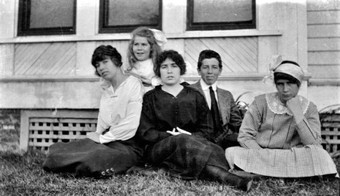
Adults and Child
As a unit of socialization, the family is the object of analysis for sociologists of the family.
12.1.2: The Functions of a Family
The primary function of the family is to perpetuate society, both biologically through procreation, and socially through socialization.
Learning Objective
Describe the different functions of family in society
Key Points
- From the perspective of children, the family is a family of orientation: the family functions to locate children socially.
- From the point of view of the parents, the family is a family of procreation: the family functions to produce and socialize children.
- Marriage fulfills many other functions: It can establish the legal father of a woman’s child; establish joint property for the benefit of children; or establish a relationship between the families of the husband and wife. These are only some examples; the family’s function varies by society.
Key Terms
- family
-
A group of people related by blood, marriage, law or custom.
- Sexual division of labor
-
The delegation of different tasks between males and females.
Example
- In some cultures, marriage imposes upon women the obligation to bear children. In northern Ghana, for example, payment of bride wealth signifies a woman’s requirement to bear children and women using birth control face substantial threats of physical abuse and reprisals.
The primary function of the family is to ensure the continuation of society, both biologically through procreation, and socially through socialization. Given these functions, the nature of one’s role in the family changes over time. From the perspective of children, the family instills a sense of orientation: The family functions to locate children socially, and plays a major role in their socialization . From the point of view of the parents, the family’s primary purpose is procreation: The family functions to produce and socialize children. In some cultures marriage imposes upon women the obligation to bear children. In northern Ghana, for example, payment of bride wealth signifies a woman’s requirement to bear children, and women using birth control face substantial threats of physical abuse and reprisals.
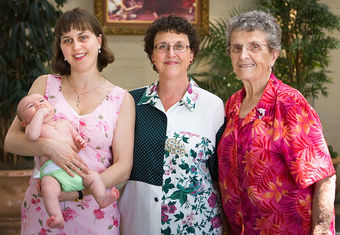
Family Background Matters
From the perspective of children, the family is a family of orientation: The family functions to locate children socially, and plays a major role in their socialization. From the point of view of the parents, the family is a family of procreation: The family functions to produce and socialize children
Other Functions of the Family
Producing offspring is not the only function of the family. Marriage sometimes establishes the legal father of a woman’s child or the legal mother of a man’s child; it oftentimes gives the husband or his family control over the wife’s sexual services, labor, and property. Marriage, likewise, often gives the wife or her family control over the husband’s sexual services, labor, and property. Marriage also establishes a joint fund of property for the benefit of children and can establish a relationship between the families of the husband and wife. None of these functions are universal, but depend on the society in which the marriage takes place and endures. In societies with a sexual division of labor, marriage, and the resulting relationship between a husband and wife, is necessary for the formation of an economically productive household . In modern societies marriage entails particular rights and privilege that encourage the formation of new families even when there is no intention of having children.
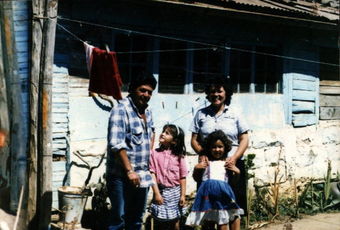
Chilean Family
In societies with a sexual division of labor, marriage, and the resulting relationship between a husband and wife, is necessary for the formation of an economically productive household.
12.1.3: Family Structures
The traditional family structure consists of two married individuals providing care for their offspring, but this is becoming more uncommon.
Learning Objective
Analyze the statistical data regarding types of family composition and living arrangements
Key Points
- The nuclear family is considered the “traditional” family. The nuclear family consists of a mother, father, and their biological children.
- A single parent is a parent who cares for one or more children without the assistance of the other biological parent.
- Step families are becoming more familiar in America. Divorce rates, along with the remarriage rate are rising, therefore bringing two families together as step families.
- The extended family consists of grandparents, aunts, uncles, and cousins.
Key Terms
- Family Structure
-
a family support system involving two married individuals providing care and stability for their biological offspring.
- nuclear family
-
a family unit consisting of at most a father, mother and dependent children.
- extended family
-
A family consisting of parents and children, along with either grandparents, grandchildren, aunts or uncles, cousins etc.
Examples
- Statistics show that there are 1,300 new stepfamilies forming every day. Over half of American families are remarried, that is 75% of marriages ending in divorce, remarry.
- Statistics show that there are 1,300 new stepfamilies forming every day. Over half of American families are remarried, that is 75% of marriages ending in divorce, remarry.
The traditional family structure in the United States is considered a family support system which involves two married individuals providing care and stability for their biological offspring. However, this two-parent, nuclear family has become less prevalent, and alternative family forms have become more common. The family is created at birth and establishes ties across generations. Those generations, the extended family of aunts, uncles, grandparents, and cousins, can all hold significant emotional and economic roles for the nuclear family.
Nuclear Family
The nuclear family is considered the “traditional” family and consists of a mother, father, and the children. The two-parent nuclear family has become less prevalent, and alternative family forms such as, homosexual relationships, single-parent households, and adopting individuals are more common. The nuclear family is also choosing to have fewer children than in the past. The percentage of married-couple households with children under 18 has declined to 23.5% of all households in 2000 from 25.6% in 1990, and from 45% in 1960. However, 64 percent of children still reside in a two-parent, household as of 2012.
Single Parent
A single parent is a parent who cares for one or more children without the assistance of the other biological parent. Historically, single-parent families often resulted from death of a spouse, for instance during childbirth. Single-parent homes are increasing as married couples divorce, or as unmarried couples have children. Although widely believed to be detrimental to the mental and physical well-being of a child, this type of household is tolerated. The percentage of single-parent households has doubled in the last three decades, but that percentage tripled between 1900 and 1950. In fact, 24 percent of children live with just their mother, and 4 percent live with just their father. The sense of marriage as a “permanent” institution has been weakened, allowing individuals to consider leaving marriages more readily than they may have in the past. Increasingly single parent families are a result of out of wedlock births, especially those due to unintended pregnancy.
Step Families
Step families are becoming more common in America. Divorce rates, along with the remarriage rate are rising, therefore bringing two families together as step families. Statistics show that there are 1,300 new step families forming every day. Over half of American families are remarried, that is 75% of marriages ending in divorce, remarry.
Extended Family
The extended family consists of grandparents, aunts, uncles, and cousins. In some circumstances, the extended family comes to live either with or in place of a member of the nuclear family. About 4 percent of children live with a relative other than a parent. For example, when elderly parents move in with their children due to old age, this places large demands on the caregivers, particularly the female relatives who choose to perform these duties for their extended family.

The traditional family in the U.S.
An American family composed of the mother, father, children, and extended family.
12.1.4: Kinship Patterns
Kinship refers to the web of social relationships that form an important part of the lives of most humans in most societies.
Learning Objective
Explain how the concept of kinship is used in anthropolgy
Key Points
- In biology, kinship typically refers to the degree of genetic relatedness or coefficient of relationships between individual members of a species.
- One of the founders of the anthropological relationship research was Lewis Henry Morgan, in his Systems of Consanguinity and Affinity of the Human Family (1871). The most lasting of Morgan’s contributions was his discovery of the difference between descriptive and classificatory kinship.
- Ideas about kinship in sociology and anthropology do not necessarily assume any biological relationship between individuals, rather just close associations.
- A unilineal society is one in which the descent of an individual is reckoned either from the mother’s or the father’s line of descent.
- With matrilineal descent individuals belong to their mother’s descent group. Similarly, with patrilineal descent, individuals belong to their father’s descent group.
- The Western model of a nuclear family consists of a couple and its children.
- With patrilineal descent, individuals belong to their father’s descent group.
- The Western model of a nuclear family consists of a couple and its children.
Key Terms
- descent
-
Lineage or hereditary derivation.
- kinship
-
relation or connection by blood, marriage, or adoption
- affinity
-
A natural attraction or feeling of kinship to a person or thing.
Example
- Ideas about kinship do not necessarily assume any biological relationship between individuals, rather just close associations. Anthropologist Bronislaw Malinowski, in his ethnographic study of sexual behavior on the Trobriand Islands noted that the Trobrianders did not believe pregnancy to be the result of sexual intercourse between the man and the woman and they denied that there was any physiological relationship between father and child.
Kinship is a term with various meanings depending upon the context. In anthropology, kinship refers to the web of social relationships that form an important part of human lives. In other disciplines, kinship may have a different meaning. In biology, it typically refers to the degree of genetic relatedness or coefficient of relationships between individual members of a species. In a more general sense, kinship may refer to a similarity or affinity between entities on the basis of some or all of their characteristics.
System of Kinship
One of the founders of anthropological relationship research was Lewis Henry Morgan, who wrote Systems of Consanguinity and Affinity of the Human Family (1871). Members of a society may use kinship terms without being biologically related, a fact already evident in Morgan’s use of the term “affinity” within his concept of the “system of kinship. ” The most lasting of Morgan’s contributions was his discovery of the difference between descriptive and classificatory kinship, which situates broad kinship classes on the basis of imputing abstract social patterns of relationships having little or no overall relation to genetic closeness.
Kinship systems as defined in anthropological texts and ethnographies were seen as constituted by patterns of behavior and attitudes in relation to the differences in terminology for referring to relationships as well as for addressing others. Many anthropologists went so far as to see, in these patterns of kinship, strong relations between kinship categories and patterns of marriage, including forms of marriage, restrictions on marriage, and cultural concepts of the boundaries of incest .
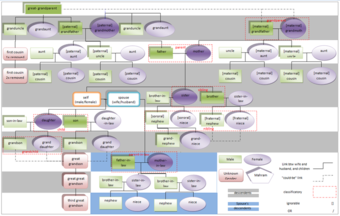
Mahrams Chart
Family chart. Note that not all relatives are shown in the chart (specially at step-relatives).
Biological Relationships
Ideas about kinship do not necessarily assume any biological relationship between individuals, rather just close associations. Malinowski, in his ethnographic study of sexual behavior on the Trobriand Islands, noted that the Trobrianders did not believe pregnancy to be the result of sexual intercourse between the man and the woman, and they denied that there was any physiological relationship between father and child. Nevertheless, while paternity was unknown in the “full biological sense,” for a woman to have a child without having a husband was considered socially undesirable. Fatherhood was therefore recognized as a social role; the woman’s husband is the “man whose role and duty it is to take the child in his arms and to help her in nursing and bringing it up”; “Thus, though the natives are ignorant of any physiological need for a male in the constitution of the family, they regard him as indispensable socially. “
Descent and the Family
Descent, like family systems, is one of the major concepts of anthropology. Cultures worldwide possess a wide range of systems of tracing kinship and descent. Anthropologists break these down into simple concepts about what is thought to be common among many different cultures. A descent group is a social group whose members have common ancestry. An unilineal society is one in which the descent of an individual is reckoned either from the mother’s or the father’s line of descent. With matrilineal descent, individuals belong to their mother’s descent group. Matrilineal descent includes the mother’s brother, who in some societies may pass along inheritance to the sister’s children or succession to a sister’s son. With patrilineal descent, individuals belong to their father’s descent group. Societies with the Iroquois kinship system are typically uniliineal, while the Iroquois proper are specifically matrilineal. The Western model of a nuclear family consists of a couple and its children. The nuclear family is ego-centered and impermanent, while descent groups are permanent and reckoned according to a single ancestor .

Kinship Systems
A broad comparison of (left, top-to-bottom) Hawaiian, Sudanese, Eskimo, (right, top-to-bottom) Iroquois, Crow and Omaha kinship systems.

Cousin Tree kinship
Family tree showing the relationship of each person to the orange person. Cousins are colored green. The genetic kinship degree of relationship is marked in red boxes by percentage (%).
12.1.5: Authority Patterns
The three main parenting styles in early child development are authoritative, authoritarian, and permissive.
Learning Objective
Describe the four different styles of parenting
Key Points
- Parenting is the process of promoting and supporting the physical, emotional, social, and intellectual development of a child, from infancy to adulthood.
- Authoritarian parenting styles can be very rigid and strict.
- Authoritative parenting relies on positive reinforcement and infrequent use of punishment.
- Permissive parenting is a parenting style in which a child’s freedom and their autonomy are valued and parents tend to rely mostly on reasoning and explanation.
- An uninvolved parenting style is when parents are often emotionally absent and sometimes even physically absent.
Key Terms
- Authoritative parenting
-
Parenting that relies on positive reinforcement and infrequent use of punishment. Parents are more aware of a child’s feelings and capabilities, and support the development of a child’s autonomy within reasonable limits.
- Uninvolved Parenting
-
The parenting style used when parents are often emotionally absent and sometimes even physically absent.
- Authoritarian parenting
-
Parenting that relies on a rigid set of rules.
Example
- In 1983, Diana Baumrind found that children raised in an authoritarian style home were less cheerful, more moody and more vulnerable to stress. In many cases these children also demonstrated passive hostility.
Parenting is the process of promoting and supporting the physical, emotional, social, and intellectual development of a child from infancy to adulthood. Parenting refers to the aspects of raising a child, aside from the biological relationship. Parenting is usually done by the biological parents of the child in question, although governments and society take a role as well. In many cases, orphaned or abandoned children receive parental care from non-parent blood relations. Others may be adopted, raised in foster care, or placed in an orphanage.
Parenting Styles
Developmental psychologist Diana Baumrind identified three main parenting styles in early child development: authoritative, authoritarian, and permissive. These parenting styles were later expanded to four, including an uninvolved style. These four styles of parenting involve combinations of acceptance and responsiveness on the one hand, and demand and control on the other. Authoritarian parenting styles can be very rigid and strict. Parents who practice authoritarian style parenting have a strict set of rules and expectations and require rigid obedience. If rules are not followed, punishment is most often used to ensure obedience. There is usually no explanation of punishment except that the child is in trouble and should listen accordingly. Authoritative parenting relies on positive reinforcement and infrequent use of punishment. Parents are more aware of a child’s feelings and capabilities and support the development of a child’s autonomy within reasonable limits. There is a give-and-take atmosphere involved in parent-child communication, and both control and support are exercised in authoritative style parenting.
Permissive parenting is most popular in middle class families. In these family settings a child’s freedom and their autonomy are valued and parents tend to rely mostly on reasoning and explanation. There tends to be little, if any, punishment or rules in this style of parenting and children are said to be free from external constraints.
An uninvolved parenting style is when parents are often emotionally absent and sometimes even physically absent. They have little to no expectation of the child and regularly have no communication. They are not responsive to a child’s needs and do not demand anything of them in terms of behavioral expectations. They provide everything the child needs for survival with little to no engagement.
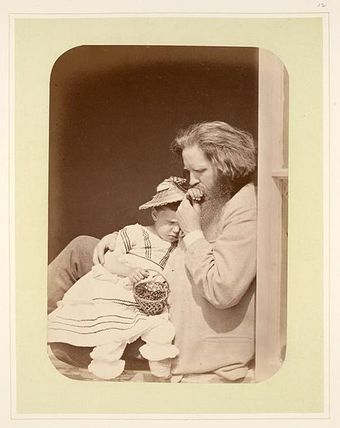
Father and Child
Parenting is the process of promoting and supporting the physical, emotional, social, and intellectual development of a child, from infancy to adulthood.
12.2: Marriage
12.2.1: The Nature of Marriage
Marriage is a social union or legal contract between people called spouses that creates kinship.
Learning Objective
Analyze different types of marriage and the similarities and differences between polygamy and polyandry
Key Points
- The reasons people marry vary widely and include, to publicly and formally declare their love, to form a single household unit, social and economic stability, and for the education and nurturing of children.
- Same-sex marriage is marriage between two persons of the same biological sex or gender identity.
- A civil union, also referred to as a civil partnership, is a legally recognized form of partnership similar to marriage.
- Group marriage is a form of polyamory in which more than two persons form a family unit. All the members of the group marriage are considered to be married to all the other members of the group marriage.
- Cohabitation is an arrangement where two people who are not married live together in an intimate relationship, particularly an emotionally and sexually intimate one, on a long-term or permanent basis.
Key Terms
- civil union
-
a legal union similar to marriage, established to allow similar rights to same-sex couples, and in some jurisdictions opposite-sex couples, as partners in traditional marriages have.
- cohabitation
-
An emotionally and physically intimate relationship that includes a common living place and which exists without legal or religious sanction.
- group marriage
-
a form of polygamous marriage in which more than one man and more than one woman form a family unit
Examples
- It is believed that same-sex unions were celebrated in Ancient Greece and Rome, some regions of China, such as Fujian, and at certain times in ancient European history.
- In the United States, although same-sex marriages are not recognized federally, same-sex couples can legally marry in six states (Connecticut, Iowa, Massachusetts, New Hampshire, New York, Vermont) and the District of Columbia and receive state-level benefits.
- In some jurisdictions, such as Brazil, New Zealand, Uruguay, France and many U.S. states, civil unions are also open to opposite-sex couples.
Marriage is a social union or legal contract between spouses that creates kinship. The most frequently occurring form of marriage is between a woman and a man, where the feminine term ‘wife’ and the masculine term ‘husband’ are generally used to describe the parties of the contract . Other forms of marriage also exist, however. For example polygamy, in which a person takes more than one spouse, exists in many societies. Currently, the legal concept of marriage is expanding to include same-sex marriage in some areas as well.

Bride and groom signing the book
The most frequently occurring form of marriage is between a woman and a man, where the feminine term ‘wife’ and the masculine term ‘husband’ are generally used to describe the parties of the contract.
Wedding Ceremony
The reasons people marry vary widely, but usually include the desire to publicly and formally declare their love, to form a single household unit, to legitimize sexual relations and procreation, for social and economic stability, and for the education and nurturing of children. A marriage can be declared by a wedding ceremony, which may be performed either by a religious officiator or through a similar government-sanctioned secular process. The act of marriage creates obligations between the individuals involved, and, in some societies, between the parties’ extended families.
Types of Marriage
Outside of the traditional marriage between monogamous heterosexual couples, other forms of marriage exist. Same-sex is marriage between two persons of the same biological sex or gender identity. Supporters of legal recognition for same-sex marriage typically refer to such recognition as marriage equality. It is believed that same-sex unions were celebrated in Ancient Greece and Rome, some regions of China, such as Fujian, and at certain times in ancient European history. In the United States, although same-sex marriages are not recognized federally, same-sex couples can legally marry in six states (Connecticut, Iowa, Massachusetts, New Hampshire, New York, Vermont) and the District of Columbia and receive state-level benefits.
A civil union, also referred to as a civil partnership, is a legally recognized form of partnership similar to marriage. Group marriage is a form of polyamory in which more than two persons form a family unit. All the members of the group marriage are considered to be married to all the other members of the group marriage. All members of the marriage share parental responsibility for any children arising from the marriage. In some jurisdictions, such as Brazil, New Zealand, Uruguay, France and the U.S. states of Hawaii and Illinois, civil unions are also open to opposite-sex couples.
Polygamy and polyandry are two less recognized (or supported) forms of marriage. In polygamy, a man usually takes on a number of different wives, although the literal translation of the term means marriage “between two or more partners”. Polyandry is specific to a woman taking on two or more husbands at a time, although it can more loosely mean having multiple sexual partners.
Cohabitation
Marriage is an institution which can join together people’s lives in a variety of emotional and economic ways. In many Western cultures, marriage usually leads to the formation of a new household comprising the married couple, with the married couple living together in the same home, often sharing the same bed, but in some other cultures this is not the tradition. Conversely, marriage is not a prerequisite for cohabitation. Cohabitation is an arrangement where two people who are not married live together in an intimate relationship, particularly an emotionally and sexually intimate one, on a long-term or permanent basis.
12.2.2: Romantic Love
Romance is the expressive and pleasurable feeling from an emotional attraction to another person, and is associated with love.
Learning Objective
Describe the origins of the conception of romantic love
Key Points
- In the context of romantic love relationships, romance usually implies an expression of one’s strong romantic love, or one’s deep and strong emotional desires to connect with another person intimately.
- The conception of romantic love was popularized in Western culture by the concept of courtly love.
- Courtship is the period in a couple’s relationship which precedes their engagement and marriage, or establishment of an agreed relationship of a more enduring kind.
- Romantic love may also be classified according to two categories, “popular romance” and “divine or spiritual” romance.
- The “tragic” contradiction between romance and social expectations is forcibly portrayed in art.
Key Terms
- intimacy
-
Feeling or atmosphere of closeness and openness towards someone else, not necessarily involving sexuality.
- courtly love
-
A mediaeval European conception of noble and chivalrous love, generally secret and between members of the nobility.
- courtship
-
The act of wooing in love; solicitation of individuals to marriage
Example
- The “tragic” contradiction between romance and society is most forcibly portrayed in literature, such as in Tolstoy’s Anna Karenina, in Flaubert’s Madame Bovary, and William Shakespeare’s Romeo and Juliet. The female protagonists in such stories are driven to suicide as if dying for a cause of freedom from various oppressions of marriage
Romance is the expressive and pleasurable feeling from an emotional attraction to another person associated with love. In the context of romantic love relationships, romance usually implies an expression of one’s strong romantic love, or one’s deep and strong emotional desires to connect with another person intimately.
During the initial stages of a romantic relationship, there is more often more emphasis on emotions—especially those of love, intimacy, compassion, appreciation, and affinity—rather than physical intimacy. Within an established relationship, romantic love can be defined as a freeing or optimizing of intimacy in a particularly luxurious manner, or perhaps in greater spirituality, irony, or peril to the relationship. In culture, arranged marriages and betrothals are customs that may conflict with romance due to the nature of the arrangement. It is possible, however, that strong romance and love can exist between the partners in an arranged marriage.
Romantic Practices
The conception of romantic love was popularized in Western culture by the concept of courtly love. Chevaliers, or knights in the Middle Ages, engaged in what were usually non-physical and non-marital relationships with women of nobility of whom they served. These relations were highly elaborate and ritualized in a complexity that was steeped in a framework of tradition, which stemmed from theories of etiquette derived out of chivalry as a moral code of conduct. Currently, courtship is the period in a couple’s relationship which precedes their engagement and marriage, or establishment of an agreed relationship of a more enduring kind. In courtship, a couple gets to know each other and decides if there will be an engagement or other such agreement. A courtship may be an informal and private matter between two people, or it may be a public affair or formal arrangement with family approval.
Types of Romantic Love
Romantic love is contrasted with platonic love which in all usages precludes sexual relations, yet only in the modern usage does it take on a fully asexual sense, rather than the classical sense in which sexual drives are sublimated. Unrequited love can be romantic in different ways: comic, tragic, or in the sense that sublimation itself is comparable to romance, where the spirituality of both art and egalitarian ideals is combined with strong character and emotions. Unrequited love is typical of the period of romanticism, but the term is distinct from any romance that might arise within it.
Romantic love may also be classified according to two categories: “popular romance” and “divine or spiritual” romance. Popular romance may include but is not limited to the following types: idealistic, normal intense, predictable as well as unpredictable, consuming, intense but out of control, material and commercial, physical and sexual, and finally grand and demonstrative. Divine romance may include, but is not limited to these following types: realistic, as well as plausible unrealistic, optimistic as well as abiding.
Tragedy and Other Social Issues
The “tragic” contradiction between romance and society is most forcibly portrayed in literature, in Tolstoy’s Anna Karenina, in Flaubert’s Madame Bovary, and William Shakespeare’s Romeo and Juliet. The female protagonists in such stories are driven to suicide as if dying for a cause of freedom from various oppressions of marriage. Reciprocity of the sexes appears in the ancient world primarily in myth where it is in fact often the subject of tragedy, for example in the myths of Theseus and Atalanta. Noteworthy female freedom or power was an exception rather than the rule, though this is a matter of speculation and debate.

Courting
The conception of romantic love was popularized in Western culture by the concept of courtly love.
12.2.3: Marital Residence
Marriage is an institution which can join together people’s lives in a variety of emotional and economic ways.
Learning Objective
Describe cohabitation trends in the U.S.
Key Points
- Cohabitation is an arrangement where two people who are not married live together in an physically and emotionally intimate relationship on a long-term or permanent basis.
- Over the years, evidence indicating cohabiting increases the likelihood of split has always been more prevalent than evidence that suggests it is helpful.
- Cohabitation in the United States became common in the late 20th century.
- Some places, including the state of California, have laws that recognize cohabiting couples as “domestic partners”.
Key Terms
- Likelihood of Split
-
The probability that a romantic union will dissolve.
- Domestic Partners
-
Two individuals who live together and share a common domestic life but are neither joined by marriage nor a civil union, yet may have other legal guarantees.
- cohabitation
-
An emotionally and physically intimate relationship that includes a common living place and which exists without legal or religious sanction.
Examples
- A scientific survey of over 1,000 married men and women in the United States found that those who moved in with a lover before engagement or marriage reported significantly lower quality marriages and a greater possibility for splitting up than other couples. About 20% of those who cohabited before getting engaged had since divorced, as compared with only 12% of those who only moved in together after getting engaged and 10% who did not cohabit prior to the marriage.
- For married couples the percentage of the relationship ending after 5 years is 20%, for cohabitators the percentage is 49%. After 10 years the percentage for the relationship to end is 33% for married couples and 62% for cohabitators.
Marriage is an institution which can join together people’s lives in a variety of emotional and economic ways. In many Western cultures, marriage usually leads to the married couple living together in the same home, often sharing the same bed. In some other cultures, this is not the tradition.
Conversely, marriage is not a prerequisite for cohabitation. Cohabitation is an arrangement where two people who are not married live together in an physically and emotionally intimate relationship on a long-term or permanent basis .
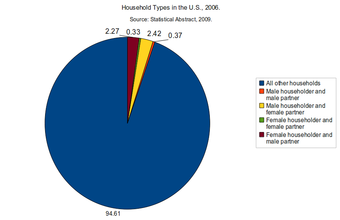
Household types in the United States in 2006
This figure shows that roughly 5% of households in the United States are made up of cohabiting couples of various types: heterosexual, gay, or, lesbian.
Conflicting studies on the effect of cohabitation on marriage have been published. But over the years, evidence indicating cohabiting increases the likelihood of split has always been more prevalent than evidence that suggests it is helpful. For married couples, the percentage of the relationship ending after five years is 20%, for cohabitators the percentage is 49%. The percentage of the relationship ending after 10 years is 33% for married couples and 62% for cohabitators.
The parenting role of cohabiting partners could also have a negative effect on the child. The partner that is not the parent, usually the father, does not have “explicit legal, financial, supervisory or custodial rights or responsibilities regarding the children of his partner” according to Waite. This can cause an unstable living arrangement for a child in which he or she acts out because the partner is “not their real parent. “
Cohabitation in the United States became common in the late 20th century. Although it is illegal in five states, a total of 4.85 million couples live together. A scientific survey of over 1,000 married men and women in the United States found that those who moved in with a lover before engagement or marriage reported significantly lower quality marriages and a greater possibility for splitting up than other couples. About 20% of those who cohabited before getting engaged had since suggested divorce, as compared with only 12% of those who only moved in together after getting engaged and 10% who did not cohabit prior to the marriage.
Some places, including the state of California, have laws that recognize cohabiting couples as domestic partners. In California, such couples are defined as people who “have chosen to share one another’s lives in an intimate and committed relationship of mutual caring,” including having a “common residence, and are the same sex or persons of opposite sex if one or both of the persons are over the age of 62. “
12.2.4: Mate Selection
There is wide cross-cultural variation in the social rules governing the selection of a partner for marriage.
Learning Objective
Differentiate between arranged marriages and forced marriages
Key Points
- An arranged marriage is an agreement in which both parties consent to the assistance of their parents or a third party.
- Endogamy refers to the rule that a marital partner must be selected from an individual’s own social group. This is common in caste-based societies.
- Exogamy refers to the rule that a marital partner must be chosen from a different group than one’s own. This is common in totemic societies.
- In other cultures, a partner can be chosen through courtship. Marriage can also be arranged by the couple’s parents through an outside party, a matchmaker.
- Forced marriage is a term used to describe a marriage in which one or both of the parties is married without consent.
- In some societies ranging from Central Asia to the Caucasus to Africa, the custom of bride kidnapping still exists, in which a woman is captured by a man and his friends.
- In some societies ranging from Central Asia to the Caucasus to Africa, the custom of bride kidnapping still exists, in which a woman is captured by a man and his friends.
Key Terms
- courtship
-
The act of wooing in love; solicitation of individuals to marriage
- matchmaker
-
someone who finds suitable marriage partners
- shotgun wedding
-
This refers to a forced wedding that occurs because a bride is already pregnant.
Example
- Arranged marriage has deep roots in royal and aristocratic families around the world. Today, arranged marriage is largely practiced in South Asia (India, Nepal, Pakistan, Bangladesh, Sri Lanka), Africa, the Middle East, and Southeast Asia. To some extent, it is also practiced in East Asia.
There is wide cross-cultural variation in the social rules that govern the selection of marriage partners. In some communities, partner selection is an individual decision, while in others, it is a collective decision made by the partners’ kin groups. Among different cultures, there is also variation in the rules regulating whom individuals can choose to marry.
Arranged Marriages
An arranged marriage is an agreement in which both parties consent to the assistance of their parents or a third party. Arranged marriage has deep roots in the behavior of royal and aristocratic families around the world. Today, arranged marriage is largely practiced in South Asia (India, Nepal, Pakistan, Bangladesh, Sri Lanka), Africa, the Middle East, and Southeast Asia. To some extent, it also occurs in parts of East Asia.
In many societies, the choice of partner is limited to suitable persons from specific social groups. In some of these societies, individuals are only allowed to select partners from the individual’s social group. This is a practice called endogamy, and is common in many class and casted-based societies, like India. In other societies, on the other hand, partners can be selected from a different social group than one’s own. This is called exogamy, and is common in societies that practice totemic religion, in which society is divided into a number of distinct, exogamous, totemic clans.
In cultures with fewer rules governing mate selection, the process of finding a partner might include courtship. It might also be arranged by an individual’s parent through an outside party, called a matchmaker.
Forced Marriages
Forced marriage is a term used to describe a marriage in which one or both parties is married without consent, against his or her will. In a shotgun wedding, a marriage between two people is forced because of an unplanned pregnancy. Some cultures and religions consider it a moral imperative to marry in such a situation. This is based on the reasoning that premarital sex, and out-of-wedlock births, are sinful, and should be outlawed or stigmatized. As the stigma associated with out-of-wedlock births has faded over the years, and the number of such births has increased, shotgun weddings have become less common. They have also become less common because of the increasing availability of birth control, abortions, and welfare support for unwed mothers. Fewer people perceive shotgun weddings to be necessary in order to support the woman and the child.
In some societies, ranging from Central Asia to Africa, the custom of bride kidnapping still exists, in which a woman is captured by a man and his friends. This practice occasionally exists to conceal an elopement, but it also occasionally represents sexual violence.
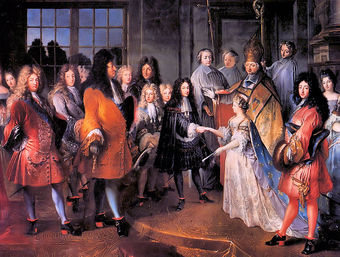
Arranged Marriages in Europe
an arranged marriage between Louis XIV of France and Maria Theresa of Spain
12.2.5: Child Rearing
Child rearing is the process of supporting the physical, emotional, social, and intellectual development of a child.
Learning Objective
Apply Baumrind’s parenting style categories to families in your own environment.
Key Points
- Parenting is usually done by the biological parents of the child in question, although governments and society play roles as well.
- Authoritarian parents have a strict set of rules and expectations. This approach controls, but also intimidates, and can inhibit a child. Rigid obedience is required.
- Authoritative parents also create clear behavioral guidelines, but this approach balances discipline with warmth. It promotes positive reinforcement, learning from mistakes, and infrequent use of punishment.
- Permissive or Indulgent parents espouse autonomy without consequences, in the name of granting a child freedom. This approach relies mostly on affection, reasoning, and explanation, and does not factor in personal responsibility.
- Uninvolved parents eschew limits altogether, and may ignore a child to the point of neglect. This is often the default approach when parents are emotionally and/or physically absent.
- The ideology of “motherhood” portrays mothers as the ultimate caregivers, however, fathers have begun to spend more caregiving time with their children.
Key Terms
- Uninvolved Parenting
-
Often applies when parents are emotionally absent and sometimes even physically absent.
- Authoritarian parenting
-
A parenting style that relies on a strict set of rules and rigid obedience.
- Authoritative parenting
-
Parenting that relies on positive reinforcement and infrequent use of punishment.
Child rearing is the process of promoting and supporting the physical, emotional, social, and intellectual development of a child from infancy to adulthood. Parenting refers to aspects of raising a child aside from the biological relationship. Parenting is usually done by the biological parents of the child in question, with governments and society playing ancillary roles. Orphaned or abandoned children are often reared by non-parent blood relations.
Parenting Styles
Developmental psychologist Diana Baumrind identified three main parenting styles in early child development: Authoritative, Authoritarian, and Permissive. These parenting styles were later expanded to four, including an Uninvolved style. They involve combinations of acceptance and responsiveness on the one hand, and demand and control on the other.
Authoritarian parenting is very rigid and strict. Parents who practice it have a set of rules and expectations, and they require rigid obedience. If rules are not followed, punishment is most often used to ensure obedience.
Authoritative parenting relies on positive reinforcement and infrequent use of punishment. These parents are more aware of a child’s feelings and capabilities, and support the development of a child’s autonomy within reasonable limits. There is a give-and-take atmosphere involved in parent-child communication, and both control and support are exercised.
With Permissive or Indulgent parenting, a child’s freedom and autonomy are valued above all. These parents rarely find fault with their child and when they do, they tend to rely mostly on reasoning and explanation. There are few rules, few consequences, and children are said to be free from external constraints.
In Uninvolved families, parents are often emotionally absent and sometimes even physically absent. Expectations and regular communication are minimal. These parents are not responsive to a child’s needs and do not demand anything of them behaviorally. They provide for basic survival, but offer little to no engagement.
Parental Roles and Responsibilities
The ideology of “motherhood” portrays mothers as the ultimate caregivers. They invest copious time in their children, which may affect their job and role in the labor market. Although stay-at-home moms are less common in today’s economy, women statistically spend more time nurturing children than men do.
However, fathers are beginning to spend more hands-on time with their children as parenting roles evolve. Couples are now more likely to share household and child-rearing responsibilities, such as bathing, dressing, feeding, changing diapers, and comforting children, along with cooking and cleaning.
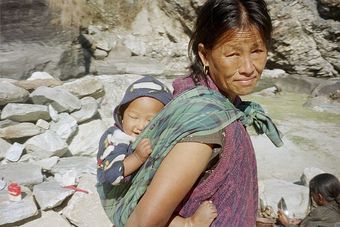
Motherhood
A Nepalese woman and her infant child.
12.3: Sociological Perspectives on Family
12.3.1: The Functionalist Perspective
Functionalists view the family unit as a construct that fulfills important functions and keeps society running smoothly.
Learning Objective
Explain the social functions of the family through the perspective of structural functionalism
Key Points
- Functionalists identify a number of functions families typically perform: reproduction; socialization; care, protection, and emotional support; assignment of status; and regulation of sexual behavior through social norms.
- For functionalists, the family creates well-integrated members of society by instilling the social culture into children.
- Radcliffe-Brown proposed that most stateless, “primitive” societies, lacking strong centralized institutions, are based on an association of descent groups. These clans emerge from family units.
Key Terms
- institution
-
An established organization, especially one dedicated to education, public service, culture, or the care of the destitute, poor etc.
- Radcliffe-Brown
-
A British social anthropologist from the early twentieth century who contributed to the development of the theory of structural-functionalism.
- family
-
A group of people related by blood, marriage, law or custom.
Example
- For functionalists, the family creates well-integrated members of society and teaches culture to the new members of society.
Structural functionalism is a framework that sees society as a complex system whose parts work together to promote solidarity and stability. In this way, society is like an organism and each aspect of society (institutions, social constructs, etc.) is like an organ that works together to keep the whole functioning smoothly. This approach looks at society through a macro-level orientation, which is a broad focus on the social structures that shape society as a whole. Functionalism addresses society in terms of the function of its constituent elements: norms, customs, traditions and institutions. Functionalists, in general, identify a number of functions families typically perform: reproduction; socialization; care, protection, and emotional support; assignment of status; and regulation of sexual behavior through the norm of legitimacy.
The Family
Radcliffe-Brown proposed that most stateless, “primitive” societies that lack strong centralized institutions are based on an association of corporate-descent groups. Structural functionalism also took on the argument that the basic building block of society is the nuclear family, and that the clan is an outgrowth, not vice versa . Durkheim was concerned with the question of how certain societies maintain internal stability and survive over time. Based on the metaphor above of an organism in which many parts function together to sustain the whole, Durkheim argued that complicated societies are held together by organic solidarity.
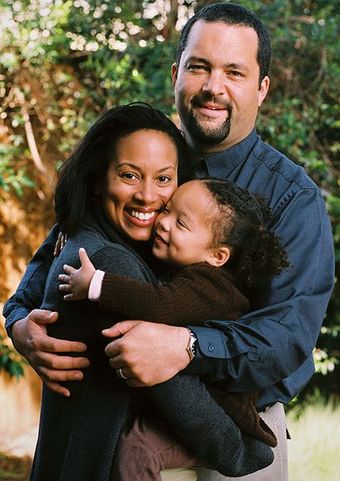
Nuclear Family
Structural functionalism also took on the argument that the basic building block of society is the nuclear family, and that the clan is an outgrowth, not vice versa.
Functions of the Family
For functionalists, the family creates well-integrated members of society and instills culture into the new members of society. It provides important ascribed statuses such as social class and ethnicity to new members. It is responsible for social replacement by reproducing new members, to replace its dying members . Further, the family gives individuals property rights and also affords the assignment and maintenance of kinship order. Lastly, families offer material and emotional security and provides care and support for the individuals who need care.
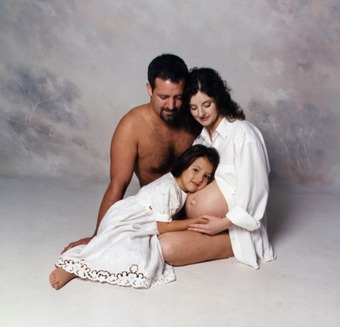
Expectant Family
Family expecting an additional family member.
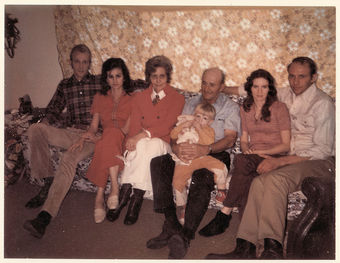
Family in the 1970s
For functionalists, the family creates well-integrated members of society and teaches culture to the new members of society.
12.3.2: The Conflict Perspective
The conflict perspective views the family as a vehicle to maintain patriarchy (gender inequality) and social inequality in society.
Learning Objective
Analyze the family from the perspective of conflict theory
Key Points
- The conflict perspective describes the inequalities that exist in all societies globally, and considers aspects of society as ways for those with power and status to maintain control over scare resources.
- According to conflict theorists, the family works toward the continuance of social inequality within a society by maintaining and reinforcing the status quo.
- Through inheritance, the wealthy families are able to keep their privileged social position for their members.
- Conflict theorists have seen the family as a social arrangement benefiting men more than women.
Key Terms
- Conflict Perspective
-
A perspective in the social sciences that emphasizes the social, political or material inequality of a social group; critiques the broad socio-political system; or otherwise detracts from structural functionalism and ideological conservativism.
- family
-
A group of people related by blood, marriage, law or custom.
- inheritance
-
The passing of title to an estate upon death.
Example
- More than 60 percent of all mothers with children under six are in the paid workforce, and such women do more housework and child care than men.
The Conflict perspective refers to the inequalities that exist in all societies globally. Conflict theory is particularly interested in the various aspects of master status in social position—the primary identifying characteristic of an individual seen in terms of race or ethnicity, sex or gender, age, religion, ability or disability, and socio-economic status. According to the Conflict paradigm, every society is plagued by inequality based on social differences among the dominant group and all of the other groups in society. When we are analyzing any element of society from this perspective, we need to look at the structures of wealth, power and status, and the ways in which those structures maintain social, economic, political and coercive power of one group at the expense of others.
The Family
According to conflict theorists, the family works toward the continuance of social inequality within a society by maintaining and reinforcing the status quo. Because inheritance, education and social capital are transmitted through the family structure, wealthy families are able to keep their privileged social position for their members, while individuals from poor families are denied similar status.
Conflict theorists have also seen the family as a social arrangement benefiting men more than women, allowing men to maintain a position of power. The traditional family form in most cultures is patriarchal, contributing to inequality between the sexes. Males tend to have more power and females tend to have less. Traditional male roles and responsibilities are valued more than the traditional roles done by their wives (i.e., housekeeping, child rearing). The traditional family is also an inequitable structure for women and children. For example, more than 60 percent of all mothers with children under six are in the paid workforce. Even though these women spend as much (or more) time at paid jobs as their husbands, they also do more of the housework and child care.
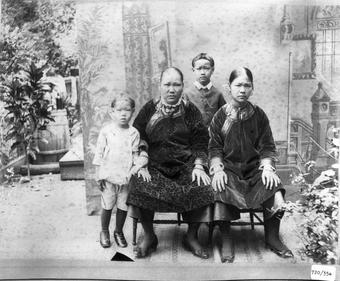
Chinese Family in Suriname
According to conflict theorists, the family works toward the continuance of social inequality within a society by maintaining and reinforcing the status quo.
12.3.3: The Symbolic Interactionist Perspective
Symbolic interactionists view the family as a site of social reproduction where meanings are negotiated and maintained by family members.
Learning Objective
Analyze family rituals through the symbolic interactionalist perspective
Key Points
- Symbolic interactionism is a theory that analyzes patterns of communication, interpretation, and adjustment between individuals in society. The theory is a framework for understanding how individuals interact with each other and within society through the meanings of symbols.
- Role-taking is a key mechanism that permits an individual to appreciate another person’s perspective and to understand what an action might mean to that person. Role-taking emerges at an early age through activities such as playing house.
- Symbolic interactionists explore the changing meanings attached to family. Symbolic interactionists argue that shared activities help to build emotional bonds, and that marriage and family relationships are based on negotiated meanings.
- The interactionist perspective emphasizes that families reinforce and rejuvenate bonds through symbolic rituals such as family meals and holidays.
Key Terms
- family
-
A group of people related by blood, marriage, law or custom.
- ritual
-
Rite; a repeated set of actions
- bonds
-
Ties and relationships between individuals.
Symbolic interactionism is a social theory that focuses on the analysis of patterns of communication, interpretation, and adjustment between individuals in relation to the meanings of symbols. According to the theory, an individual’s verbal and nonverbal responses are constructed in expectation of how the initial speaker will react.
This emphasis on symbols, negotiated meaning, and the construction of society as an aspect of symbolic interactionism focuses attention on the roles that people play in society. Role-taking is a key mechanism through which an individual can appreciate another person’s perspective and better understand the significance of a particular action to that person. Role-taking begins at an early age, through such activities as playing house and pretending to be different people. These activities have an improvisational quality that contrasts with, say, an actor’s scripted role-playing. In social contexts, the uncertainty of roles places the burden of role-making on the people in a given situation.
Ethnomethodology, an offshoot of symbolic interactionism, examines how people’s interactions can create the illusion of a shared social order despite a lack of mutual understanding and the presence of differing perspectives. Harold Garfinkel demonstrated this situation through so-called experiments in trust, or breaching experiments, wherein students would interrupt ordinary conversations because they refused to take for granted that they knew what the other person was saying.
The Family
Symbolic interactionists also explore the changing meanings attached to family. They argue that shared activities help to build emotional bonds among family members, and that marriage and family relationships are based on negotiated meanings. The interactionist perspective emphasizes that families reinforce and rejuvenate bonds through symbolic mechanism rituals such as family meals and holidays.
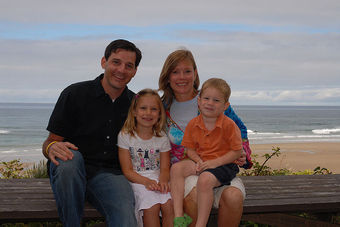
The Family
Symbolic interactionists explore the changing meanings attached to family. They argue that shared activities help to build emotional bonds and that marriage and family relationships are based on negotiated meanings.
12.3.4: The Feminist Perspective
Feminists view the family as a historical institution that has maintained and perpetuated sexual inequalities.
Learning Objective
Describe the goals of first and second-wave feminism
Key Points
- Feminism is a broad term that is the result of several historical social movements attempting to gain equal economic, political, and social rights for women.
- First-wave feminism focused mainly on legal equality, such as voting, education, employment, the marriage laws, and the plight of intelligent, white, middle-class women.
- Second-wave feminism went a step further is seeking equality in family, employment, reproductive rights, and sexuality.
- Both feminist and masculinist authors have decried predetermined gender roles as unjust.
Key Term
- gender
-
The socio-cultural phenomenon of the division of people into various categories such as male and female, with each having associated roles, expectations, stereotypes, etc.
Example
- In the United States, 82.5 million women are mothers, while the national average age of first child births is 25.1 years. In 2008, 10% of births were to teenage girls, and 14% were to women ages 35 and older.
Feminism is a broad term that is the result of several historical social movements attempting to gain equal economic, political, and social rights for women. First-wave feminism focused mainly on legal equality, such as voting, education, employment, marriage laws, and the plight of intelligent, white, middle-class women. Second-wave feminism went a step further by seeking equality in family, employment, reproductive rights, and sexuality. Although there was great improvements with perceptions and representations of women that extended globally, the movement was not unified and several different forms of feminism began to emerge: black feminism, lesbian feminism, liberal feminism, and social feminism.
Sociology of Motherhood
In many cultures, especially in a traditional western one, a mother is usually the wife in a married couple. Her role in the family is celebrated on Mother’s Day. Some often view mothers’ duties as raising and looking after their children every minute of every day. Mothers frequently have a very important role in raising offspring, and the title can be given to a non-biological mother that fills this role. This is common in stepmothers (female married to biological father). In most family structures, the mother is both a biological parent and a primary caregiver.
However, this limited role has increasingly been called into question. Both feminist and masculist authors have decried such predetermined roles as unjust. In the United States, 82.5 million women are mothers of all ages, while the national average age of first child births is 25.1 years. In 2008, 10% of births were to teenage girls, and 14% were to women ages 35 and older.

Women’s Rights
International Women’s Day rally in Dhaka, Bangladesh, organized by the National Women Workers Trade Union Centre on March 8, 2005.
12.4: Recent Changes in Family Structure
12.4.1: The Decline of the Traditional Family
One parent households, cohabitation, same sex families, and voluntary childless couples are increasingly common.
Learning Objective
Summarize the prevalence of single parents, cohabitation, same-sex couples, and unmarried individuals
Key Points
- One recent trend illustrating the changing nature of families is the rise in prevalence of single-parent families.
- Cohabitation is an intimate relationship that includes a common living place and which exists without the benefit of legal, cultural, or religious sanction.
- While homosexuality has existed for thousands of years among human beings, formal marriages between homosexual partners is a relatively recent phenomenon.
- Voluntary childlessness in women is defined as women of childbearing age who are fertile and do not intend to have children.
Key Terms
- cohabitation
-
An emotionally and physically intimate relationship that includes a common living place and which exists without legal or religious sanction.
- Voluntary Childlessness
-
Women of childbearing age who are fertile and do not intend to have children, women who have chosen sterilization, or women past childbearing age who were fertile but chose not to have children.
Examples
- The cohabiting population, although inclusive of all ages, is mainly made up of those between the ages of 25 and 34. In 2005, the U.S. Census Bureau reported 4.85 million cohabiting couples, up more than 1,000% from 1960, when there were 439,000 such couples.
- The cohabiting population, although inclusive of all ages, is mainly made up of those between the ages of 25 and 34. In 2005, the U.S. Census Bureau reported 4.85 million cohabiting couples, up more than 1,000 percent from 1960, when there were 439,000 such couples.
Family structures of some kind are found in every society. Pairing off into formal or informal marital relationships originated in hunter-gatherer groups to forge networks of cooperation beyond the immediate family. Intermarriage between groups, tribes, or clans was often political or strategic and resulted in reciprocal obligations between the two groups represented by the marital partners. Even so, marital dissolution was not a serious problem as the obligations resting on marital longevity were not particularly high.
One Parent Households
One recent trend illustrating the changing nature of families is the rise in prevalence of single-parent families. While somewhat more common prior to the twentieth century due to the more frequent deaths of spouses, in the late nineteenth and early twentieth centuries, the nuclear family became the societal norm in most Western nations. But what was the prevailing norm for much of the twentieth century is no longer the actual norm, nor is it perceived as such.
In the 1960s and 1970s, the change in the economic structure of the United States–-the inability to support a nuclear family on a single wage–-had significant ramifications on family life. Women and men began delaying the age of first marriage in order to invest in their earning power before marriage by spending more time in school. The increased levels of education among women, with women now earn more than 50% of bachelor’s degrees, positioned women to survive economically without the support of a husband. By 1997, 40% of births to unmarried American women were intentional and, despite a still prominent gender gap in pay, women were able to survive as single mothers.
Cohabitation
Cohabitation is an intimate relationship that includes a common living place and which exists without the benefit of legal, cultural, or religious sanction. It can be seen as an alternative form of marriage, in that, in practice, it is similar to marriage, but it does not receive the same formal recognition by religions, governments, or cultures. The cohabiting population, although inclusive of all ages, is mainly made up of those between the ages of 25 and 34. In 2005, the U.S. Census Bureau reported 4.85 million cohabiting couples, up more than 1,000% from 1960, when there were 439,000 such couples. More than half of couples in the United States lived together, at least briefly, before walking down the aisle.
Same-Sex Unions
While homosexuality has existed for thousands of years among human beings, formal marriages between homosexual partners is a relatively recent phenomenon. As of 2009, only two states in the United States recognized marriages between same-sex partners, Massachusetts and Iowa, where same-sex marriage was formally allowed as of May 17, 2004 and April 2009, respectively. Three additional states allow same-sex civil unions, New Jersey, Connecticut, and Vermont. Between May 2004 and December 2006, 7,341 same-sex couples married in Massachusetts. Assuming the percentage of homosexuals in Massachusetts is similar to that of the rest of the nation, the above number indicates that 16.7% of homosexuals in Massachusetts married during that time. Massachusetts is also the state with the lowest divorce rate.
Same sex couples, while becoming increasingly more common, still only account for about 1 percent of American households, according to 2010 Census data. About 0.5 percent of American households were same-sex couples in 2000, so this number has doubled, and it is expected to continuing increasing by the next Census data.
Childfree Couples
Voluntary childlessness in women is defined as women of childbearing age who are fertile and do not intend to have children, women who have chosen sterilization, or women past childbearing age who were fertile but chose not to have children. Individuals can also be “temporarily childless” or do not currently have children but want children in the future. The availability of reliable contraception along with support provided in old age by systems other than traditional familial ones has made childlessness an option for some people in developed countries. In most societies and for most of human history, choosing to be childfree was both difficult and undesirable. To accomplish the goal of remaining childfree, some individuals undergo medical sterilization or relinquish their children for adoption.
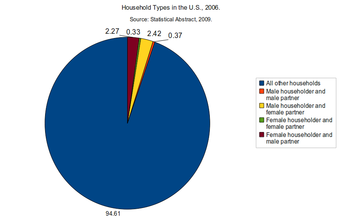
Household types in the United States in 2006
This figure shows that roughly 5% of households in the United States are made up of cohabiting couples of various types: heterosexual, gay, or, lesbian.
12.4.2: Change in Marriage Rate
Over the past three decades, marriage rates in the United States have increased for all racial and ethnic groups.
Learning Objective
Recognize changes in marriage patterns
Key Points
- Marriage is a social union or legal contract between people, called spouses, that creates kinship.
- Marriage laws have changed over the course of United States history, including the removal of bans on interracial marriage.
- Of all racial categories considered by the U.S. Census, African-Americans have married the least.
- Of all racial categories considered by the U.S. Census, Hispanics have married the most.
- The average family income for married households is higher than the average family income of unmarried households. However, marriage rates have increased for poverty-stricken populations as well.
Key Terms
- wedding
-
Marriage ceremony; a ritual officially celebrating the beginning of a marriage.
- Marriage Laws
-
The legal requirements that determine the validity of a marriage.
Examples
- According to the United States Census Bureau, 2,077,000 marriages occurred in the United States in 2009. The median age for the first marriage of an American has increased in recent years; the median age in the early 1970s was 21 for women and 23 for men, and rose to 26 for women and 28 for men by 2009.
- As of 2006, 55.7% of Americans age 18 and over were married.
- African Americans have married the least of all of the predominant ethnic groups in the U.S. with a 29.9% marriage rate, but have the highest separation rate which is 4.5%.
- African Americans have married the least of all of the predominant ethnic groups in the U.S. with a 29.9% marriage rate, but have the highest separation rate which is 4.5%.
- According to the 2010 U.S. Census Bureau, the average family income is higher than previous years at $62,770. The percentage of family households below the poverty line in 2011 was 15.1%, higher than in 2000 when it was 11.3%.
Marriage is a social union or legal contract between people, called spouses, that creates kinship. The definition of marriage varies according to different cultures, but is usually an institution in which interpersonal relationships, usually intimate and sexual, are acknowledged. Such a union is often formalized through a wedding ceremony.
Marriage Rates in the United States
Marriage laws have changed over the course of United States history, including the removal of bans on interracial marriage. In the twenty-first century, laws have been passed enabling same-sex marriages in several states. According to the United States Census Bureau, 2,077,000 marriages occurred in the United States in 2009. The median age for the first marriage of an American has increased in recent years; the median age in the early 1970s was 21 for women and 23 for men, and rose to 26 for women and 28 for men by 2009. As of 2006, 55.7% of Americans age 18 and over were married. According to the 2008-2010 American Community Survey 3-Year Estimates, males over the age of 15 have married at a rate of 51.5%. Females over the age of 15 have married at a rate of 47.7%. The separation rate is 1.8% for males and 0.1% for females.
Marriage Trends
African Americans have married the least of all of the major ethnic groups in the U.S., with a 29.9% marriage rate, but have the highest separation rate which is 4.5%. This results in a high percentage of single mother households among African Americans compared with other ethnic groups (White, African American, Native Americans, Asian, Hispanic). This can lead a child to become closer to his/her mother, the only caregiver. Yet one parent households are also more susceptible to economic difficulties. Native Americans have the second lowest marriage rate at 37.9%. Hispanics have a 45.1% marriage rate, with a 3.5% separation rate.
In the United States, the two ethnic groups with the highest marriage rates included Asians with 58.5%, and Whites with 52.9%. Asians have the lowest rate of divorce among the main groups with 1.8%. Whites, African Americans, and Native Americans have the highest rates of being widowed, ranging from 5%-6.5%. They also have the highest rates of divorce among the three, ranging from 11%-13%, with Native Americans having the highest divorce rate.
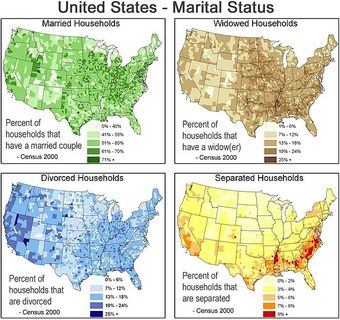
Marital Status in the United States Chart
This image depicts marital status in the U.S.
According to the 2010 U.S. Census Bureau, the average family income is higher than previous years, at $62,770. Nevertheless, the percentage of family households below the poverty line in 2011 was 15.1%, higher than in 2000 when it was 11.3%.
12.4.3: Unmarried Mothers
With the rise of single-parent households, unmarried mothers have become more common in the United States.
Learning Objective
Discuss the factors involved in the increasing number of single-parent households
Key Points
- One recent trend illustrating the changing nature of families is the rise in prevalence of single-parent household.
- The expectation of single mothers as primary caregiver is a part of traditional parenting trends between mothers and fathers.
- In the United States, 27% of single mothers live below the poverty line, as they lack the financial resources to support their children when the birth father is unresponsive.
Key Terms
- nuclear family
-
a family unit consisting of at most a father, mother and dependent children.
- Primary Caregiver
-
The person who takes primary responsibility for someone who cannot care fully for themselves.
Example
- In 1990, 73% of births to unmarried women were unintended at the time of conception, compared to about 44% of births overall.
One recent trend illustrating the changing nature of families is the rise in prevalence of the single-parent household. While somewhat more common prior to the 20th century due to the more frequent deaths of spouses, the nuclear family became the societal norm in most Western nations. But what was the prevailing norm for much of the 20th century is no longer the actual norm, nor is it perceived as such.
Since the 1960s, there has been a marked increase in the number of children living with a single parent. The 1960 United States Census reported that 9% of children were dependent on a single parent; this number that has increased to 28% by the 2000 US Census. The spike was caused by an increase in unmarried pregnancies, which 36% of all births by unmarried women, and to the increasing prevalence of divorces among couple.
The prevalence of single mothers as primary caregiver is a part of traditional parenting trends between mothers and fathers. In the United States, 27% of single mothers live below the poverty line, as they lack the financial resources to support their children when the birth father is unresponsive. Although the public is sympathetic with low-wage single mothers, government benefits are fairly low. Many seek assistance by living with another adult, such as a relative, fictive kin, or significant other. Divorced mothers who re-marry have fewer financial struggles than unmarried single mothers, who cannot work for longer periods of time without shirking their child-caring responsibilities. Unmarried mothers are thus more likely to cohabit with another adult. In the United States, the rate of unintended pregnancy is higher among unmarried couples than among married ones. In 1990, 73% of births to unmarried women were unintended at the time of conception, compared to about 44% of births overall.

Single Motherhood
Marisa Beagle, sophomore history major, and her daughter, Noelle, sit in the parking lot of the Salem Campus, where she attends school 45 minutes away from her home in East Palestine, near the Pennsylvania border. Marisa and Noelle, 18 months, live with Marisa’s parents. A single parent, Beagle says it’s tough to attend school and raise a daughter simultaneously, but with the support of her family, she’s able to make it work.
12.4.4: The “Sandwich Generation” and Elder Care
Elderly care is the fulfillment of the special needs and requirements that are unique to senior citizens.
Learning Objective
Describe the challenges of elderly care in the U.S.
Key Points
- The Sandwich generation is a generation of people who care for their aging parents while supporting their own children.
- Elderly care encompasses such services as assisted living, adult day care, long-term care, nursing homes, hospice care, and in-home care, as well as less formalized caretaking, such as by an elder’s grown child.
- Given the choice, most elders would prefer to continue to live in their own homes rather than move to an elder home or caretaking facility.
- Respite care allows caregivers the opportunity to go on vacation or a business trip and know that their elder has good quality temporary care. Without this help, the elder might have to move permanently to an outside facility.
Key Terms
- Respite Care
-
Temporary care that allows caregivers the opportunity to go on vacation or a business trip and know that their elder has good quality temporary care, for without this help the elder might have to move permanently to an outside facility.
- sandwich generation
-
The generation of persons who are the children of baby boomers, whose lifestyle is governed by the fact that they must simultaneously care for the needs of their children and their own elderly parents.
Examples
- According to the Pew Research Center, just over 1 of every 8 Americans aged 40 to 60 is both raising a child and caring for a parent, in addition to between 7 to 10 million adults caring for their aging parents from a long distance. US Census Bureau statistics indicate that the number of older Americans aged 65 or older will double by the year 2030, to over 70 million.
- According to the U.S Department of Health and Human Services the older population—persons 65 years or older—numbered 39.6 million in 2009. They represented 12.9 percent of the U.S. population, about one in every eight Americans. By 2030, there will be about 72.1 million older persons, more than twice their number in 2000.
Elderly care is the fulfillment of the special needs and requirements that are unique to senior citizens. This broad term encompasses such services as assisted living, adult day care, long-term care, nursing homes, hospice care, and in-home care. Because of the wide variety of elderly care found globally, as well as different cultural perspectives on elderly citizens, the subject cannot be limited to any one practice. For example, many countries in Asia use government-established elderly care quite infrequently, preferring the traditional methods of being cared for by younger generations of family members.
Elderly Care in the United States
The form of elderly care provided varies greatly among countries and is changing rapidly. According to the U.S Department of Health and Human Services, the older population—persons 65 years or older—numbered 39.6 million in 2009. They represented 12.9% of the U.S. population, or about one in every eight Americans. By 2030, there will be about 72.1 million older persons, more than twice their number in 2000. In the United States, most of the large multi-facility providers are publicly owned and managed as for-profit businesses. Given the choice, most elders would prefer to continue to live in their own homes. Unfortunately, the majority of elderly people gradually lose functioning ability and require either additional assistance in the home or a move to an eldercare facility. The adult children of these elders often face a difficult challenge in helping their parents make the right choices.
One relatively new service in the United States that can help keep the elderly in their homes longer is respite care. This type of care allows caregivers the opportunity to go on vacation or a business trip and know that their elder has good quality temporary care. Without this help, the elder might have to move permanently to an outside facility. Another unique type of care cropping in U.S. hospitals is called acute care of elder units, or ACE units, which provide “a homelike setting” within a medical center specifically for the elderly.
The Sandwich Generation
The Sandwich generation is a generation of people who care for their aging parents while supporting their own children. According to the Pew Research Center, just over 1 of every 8 Americans aged 40 to 60 is both raising a child and caring for a parent, in addition to between 7 to 10 million adults caring for their aging parents from a long distance.

Elderly Care
Wishaw General Hospital
12.4.5: Childless Couples
Voluntary childlessness in women is defined as women of childbearing age who are fertile and do not intend to have children.
Learning Objective
Discuss the factors involved in voluntary childlessness
Key Points
- To accomplish the goal of remaining childfree, some individuals undergo medical sterilization or relinquish their children for adoption.
- The factors involved in voluntary childlessness include age, income, unmarried status, and higher education.
- Most societies place a high value on parenthood in adult life, so that people who remain childless intentionally are sometimes stereotyped as being “individualistic” people who avoid social responsibility and are less prepared to commit themselves to helping others.
Key Terms
- Childfree
-
Childfree (sometimes spelled child-free), also known as voluntary childlessness, is a form of childlessness. Voluntary childlessness in women is defined as women of childbearing age who are fertile and do not intend to have children, women who have chosen sterilization, or women past childbearing age who were fertile but chose not to have children.
- sterilization
-
A procedure to permanently prevent an organism from reproducing.
Examples
- According to 2004 U.S. Census Bureau data, the proportion of childless women 15 to 44 years old was 44.6%, up from 35% in 1976.
- According to 2004 U.S. Census Bureau data, the proportion of childless women 15 to 44 years old was 44.6 percent, up from 35 percent in 1976.
Childless Couples
Voluntary childlessness in women is defined as women of childbearing age who are fertile and do not intend to have children, women who have chosen sterilization, or women past childbearing age who were fertile but chose not to have children. Individuals can also be “temporarily childless” but want children in the future. The availability of reliable contraception along with support provided in old age by systems other than traditional familial ones has made childlessness an option for some people in developed countries. In most societies and for most of human history, choosing to be childfree was both difficult and undesirable. To accomplish the goal of remaining childfree, some individuals undergo medical sterilization or relinquish their children for adoption.
Factors Involved in Voluntary Childlessness
First, while younger women are more likely to be childless, older women are more likely to state that they intend to remain childless in the future. Thus age plays a significant role in the decision. Further, according to 2004 U.S. Census Bureau data, the proportion of childless women 15 to 44 years old was 44.6%, up from 35% in 1976. The higher a woman’s income, the less likely she is to have children: Nearly half of women with annual incomes over $100,000 are childless. Third, being unmarried is one of the strongest predictors of childlessness.
Research also suggests that married individuals who were concerned about the stability of their marriages were more likely to remain childless. Most studies on this subject find that higher income predicted childlessness. However, some women report that the lack of financial resources was a reason why they decided to remain childless. Childless women in the developed world often express the view that women ultimately have to make a choice between motherhood and having a career. Lastly, the chance of being childless was far greater for never married women (35 to 44 yrs old), 82.5% vs. ever-married (12.9%). Chance of childlessness (age 35 to 44) by education level: graduate or professional degree (27.6%) vs non high school graduate (13.5%), high school graduate (14.3%), some college but no degree (24.7%), associate degree (11.4%), and bachelor’s degree (18.2%). The higher the level of education, the more likely a woman is to remain childless.
Social Attitudes to Remaining Childless
Most societies place a high value on parenthood in adult life, so that people who remain childless intentionally are sometimes stereotyped as being “individualistic” people who avoid social responsibility and are less prepared to commit themselves to helping others. With the advent of environmentalism and concerns for stewardship, those choosing to not have children are also sometimes recognized as helping reduce our impact, such as members of the voluntary human extinction movement . Some childless individuals are sometimes applauded on moral grounds, such as members of philosophical or religious groups, like the shakers.

Voluntary Human Extinction Movement
With the advent of environmentalism and concerns for stewardship, those choosing to not have children are also sometimes recognized as helping reduce our impact, such as members of the voluntary human extinction movement.
Some opponents of the childfree choice consider such a choice to be “selfish.” The rationale of this position is the assertion that raising children is a very important activity. Proponents of child freedom posit that choosing not to have children is no more or less selfish than choosing to have children. In fact, choosing to have children may be the more selfish choice, especially when poor parenting risks creating many long-term problems for both the children themselves and society at large.
Organizations and Political Activism
Childfree individuals do not necessarily share a unified political or economic philosophy, and most prominent childfree organizations tend to be social in nature. Childfree social groups first emerged in the 1970s, most notable among them The National Organization for Non-Parents and No Kidding! in North America. Numerous books have been written about childfree people and a range of social positions related to childfree interests have developed along with political and social activism in support of these interests. The term “childfree” was used in a July 3, 1972 Time article on the creation of the National Organization for Non-Parents. It was revived in the 1990s when Leslie Lafayette formed a later childfree group, the Childfree Network.
12.4.6: Change in Household Size
Household models include the single family and blended family home, shared housing, and group homes for people with special needs.
Learning Objective
Describe different household models
Key Points
- A shared house is a household in which a group of usually unrelated people reside together.
- A group home is a private residence designed to serve children or adults with chronic disabilities or special needs. This type of home usually has a maximum of six residents and a trained caregiver available 24 hours a day.
- A boarding house is a house in which lodgers rent one or more rooms for one or more nights, and sometimes for extended periods of weeks, months and years.
- People who live together in a shared house are called roommates.
- A single room occupancy is a single room dwelling or a multiple-tenant building that houses one or two people in individual rooms.
Key Terms
- Group Home
-
A private residence designed to serve children or adults with chronic disabilities. Typically there are no more than six residents and there is a trained caregiver there twenty-four hours a day.
- Single Room Occupancy
-
A multiple-tenant building that houses one or two people in individual rooms (or to the single room dwelling itself).
- roommate
-
A person with whom one shares an apartment or house (UK: flatmate or housemate).
Household models in Anglophone culture include the single family and varieties of blended families, shared housing, and group homes for people with support needs. Other models of living situations that may meet definitions of a household include boarding houses, a house in multiple occupations in Great Britain, and a single room occupancy in the United States.
Shared Houses
A shared house is a household in which a group of often-unrelated people reside together. The term generally applies to people living together in rental properties rather than in properties in which any resident is an owner-occupier. A shared house is formed when a group of people move into a rental property; typically, one or more of these people has applied to rent the property through a real estate agent, been accepted, and signed a lease. People who live together in a shared house are called roommates. In both developed and developing countries, shared housing is an increasingly popular household model. This is due to a variety of economic and social changes, such as the declining affordability of home ownership, as well as delayed marriage and decreasing marriage rates.
Group Homes
A group home is a private residence designed to serve children or adults with chronic disabilities. Group homes typically have a maximum of six residents and a trained, on-site caregiver available 24 hours a day. Residents of group homes usually have either a chronic mental disorder or a physical disability that prevents them from living independently. They need regular assistance in order to complete daily tasks, such as taking medication or bathing. Other residents may be developmentally disabled, recovering from alcohol or drug addiction, or abused, troubled, or neglected youths. Some residents have behavioral problems that are potentially dangerous to themselves or others and require constant supervision. Since the 1970s, group homes have assumed the role of earlier institutions such as asylums, poorhouses, and orphanages.
Boarding Houses
In a boarding house, lodgers rent one or more rooms for a period ranging from one night to weeks, months, or even years. Common areas of the house are maintained and services like laundry and cleaning may be provided. Boarding houses usually offer bed and board, or at least some meals as well as accommodation. Formerly, boarders would typically share washing, breakfast, and dining facilities; in recent years, individual rooms have tended to have their own washing and toilet facilities.
Single Room Occupancy
A single room occupancy is a single room dwelling or multiple-tenant building that houses one or two people in individual rooms. As the value of urban land has increased, many of these properties have been renovated and made available at higher prices. This has played a role in the displacement of lower-income people who once lived in these properties; it has also been cited as a reason for the visible rise in homelessness across America since the early 1980s.

Boott Boardinghouse Store
Boott Mills Boardinghouse and Storehouse, now restored and part of Lowell National Historic Park. Lowell, Massachusetts
12.4.7: Women in the Labor Force
Women in the workforce have faced barriers, though they have greater access to education and employment in the contemporary era.
Learning Objective
Discuss three factors that restrict women’s access to certain occupations
Key Points
- Women have participated in the workforce for as long as men have, yet women have been challenged by inequality in the workforce.
- Historically, women’s lack of access to higher education effectively excluded them from the practice of well-paid and high status occupations.
- Access to higher education remains a significant barrier to women’s full participation in the workforce in developing countries.
- The gender pay gap is the difference between male and female earnings expressed as a percentage of male earnings.
- The feminization of the workplace is a label given to the trend towards greater employment of women and of men willing and able to operate with these more ‘feminine’ modes of interaction.
Key Terms
- Wage Gap
-
The difference between male and female earnings expressed as a percentage of male earnings.
- occupation
-
A regular activity performed in exchange for payment, including jobs and professions.
- Feminization of the Workplace
-
A label given to the trend towards greater employment of women and of men willing and able to operate with these more ‘feminine’ modes of interaction.
Example
- The 2008 edition of the Employment Outlook report by the Organisation for Economic Co-operation and Development (OECD) found that, while female employment rates have expanded considerably and the gender employment and wage gaps have narrowed virtually everywhere, women still have 20% less chance to have a job than men, on average, and they are paid 17% less than their male counterparts.
Women in the workforce earning wages or a salary are part of a modern phenomenon, one that developed at the same time as the growth of paid employment for men; yet women have been challenged by inequality in the workforce. Until modern times, legal and cultural practices, combined with the inertia of longstanding religious and educational conventions, restricted women’s entry and participation in the workforce. Economic dependency upon men has had the same impact, particularly as occupations have become professionalized over the 19th and 20th centuries.
Historically, women’s lack of access to higher education had effectively excluded them from the practice of well-paid and high status occupations. Entry of women into the higher professions like law and medicine was delayed in most countries due to women being denied entry to universities and qualification for degrees; for example, Cambridge University only fully validated degrees for women late in 1947, and even then only after much opposition and acrimonious debate.
Barriers to Equal Participation
As gender roles have followed the formation of agricultural and then industrial societies, newly developed professions and fields of occupation have been frequently inflected by gender. Some examples of the ways in which gender affects a field include: prohibitions or restrictions on members of a particular gender entering a field or studying a field; discrimination within a field, including wage, management, and prestige hierarchies; expectation that mothers, rather than fathers, should be the primary childcare providers.
Access to Education and Training
A number of occupations became “professionalized” through the 19th and 20th centuries, gaining regulatory bodies, and passing laws or regulations requiring particular higher educational requirements. As women’s access to higher education was often limited, this effectively restricted women’s participation in these professionalizing occupations. For instance, women were completely forbidden access to Cambridge University until 1868, and were encumbered with a variety of restrictions until 1987, when the university adopted an equal opportunity policy. Numerous other institutions in the United States and Western Europe began opening their doors to women over the same period of time, but access to higher education remains a significant barrier to women’s full participation in the workforce in developing countries.
Access to Capital
Women’s access to occupations requiring capital outlays is also hindered by their unequal access to capital; this affects occupations such as entrepreneur and small business owner, farm ownership, and investor. Numerous microloan programs attempt to redress this imbalance, targeting women for loans or grants to establish start-up businesses or farms, having determined that aid targeted to women can disproportionately benefit a nation’s economy.
Discrimination within Occupations
The gender pay gap is the difference between male and female earnings expressed as a percentage of male earnings, according to the OECD. The European Commission defines it as the average difference between men and women’s hourly earnings. There is a debate to what extent this is the result of gender differences, implicit discrimination due to lifestyle choices (e.g., number of hours worked, need for maternity leave), or because of explicit discrimination. The 2008 edition of the Employment Outlook report by the Organisation for Economic Co-operation and Development (OECD) found that, while female employment rates have expanded considerably and the gender employment and wage gaps have narrowed virtually everywhere, women still have 20% less chance to have a job than men, on average, and they are paid 17% less than their male counterparts.
Feminization of the Workplace
In response to the pressure from feminism and cultural trends highlighting characteristics in workers that have culturally been associated with women, feminization of the workplace is a label given to the trend towards greater employment of women, and of men willing and able to operate with these more ‘feminine’ modes of interaction.
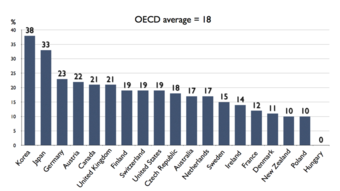
OECD Gender Pay Gap
Gender Pay Gap in 19 OECD countries according to the 2008 OECD Employment Outlook report
12.5: Divorce
12.5.1: Divorce and Its Legal Ramifications
Divorce is the final termination of a marital union, canceling the legal duties and responsibilities of marriage between the parties.
Learning Objective
Describe fault-based and no-fault divorce systems
Key Points
- Though divorce laws vary among jurisdictions, there are two basic approaches to divorce: fault based and no-fault based.
- Under a no-fault divorce system, divorce requires no allegation or proof of fault of either party; spouses can divorce simply because they no longer wish to remain married.
- Fault-based divorce systems require proof by one party that the other party has committed an act incompatible to the marriage.
- A summary divorce is used when spouses meet certain eligibility requirements or can agree on key issues beforehand. When a summary divorce is issued, the divorce does not go to trial.
- In a divorce mediation session, a mediator facilitates the discussion between the two parties by assisting with communication and providing information and suggestions to help resolve differences.
- For same-sex couples, divorce law is in its infancy and is less than clear on how such unions may be legally dissolved.
- For same-sex couples, divorce law is in its infancy and is less than clear on how such unions may be legally dissolved.
Key Terms
- Summary Divorce
-
When spouses meet certain eligibility requirements or can agree on key issues beforehand to avoid having a trial to dissolve a marriage.
- Uncontested Divorces
-
When the parties can agree and present the court with a fair and equitable agreement, approval of the divorce is almost guaranteed.
- Divorce Mediation Session
-
When a mediator facilitates the discussion between the two parties by assisting with communication and providing information and suggestions to help resolve differences. At the end of the mediation process, the separating parties have typically developed a tailored divorce agreement that can be submitted to the court.
Examples
- Under a no-fault divorce system, divorce requires no allegation or proof of fault of either party. The barest of assertions suffice. For example, in countries that require “irretrievable breakdown,” the mere assertion that the marriage has broken down will satisfy the judicial officer.
- For same-sex couples, divorce law is in its infancy and is less than clear on how such unions may be legally dissolved. For example, if a same-sex couple is married in a state that recognizes gay marriage but returns to reside in a state that does not, they might find themselves in a situation where their own state, in failing to recognize their union will also fail to enable them to divorce.
Divorce is the final termination of a marital union, canceling the legal duties and responsibilities of marriage, and dissolving the bonds of matrimony between the parties. Divorce laws vary considerably around the world, but in most countries it requires the sanction of a court or other authority in a legal process. The legal process of divorce may also involve issues of alimony, child custody, child support, distribution of property, and division of debt. Between 1971 and 2011, several countries legalized divorce, the last one being Malta in 2011.
Types of Divorce
Though divorce laws vary among jurisdictions, there are two basic approaches to divorce: fault based, and no-fault based. Under a no-fault divorce system, divorce requires no allegation or proof of fault of either party. The barest of assertions suffice. For example, in countries that require “irretrievable breakdown,” the mere assertion that the marriage has broken down will satisfy the judicial officer. By contrast, fault-based divorce systems require proof by one party that the other party has committed an act incompatible to the marriage. This is termed “grounds” for divorce (popularly called “fault”) and is the only way to terminate a marriage under a fault-based system.
A summary divorce, available in some jurisdictions, is used when spouses meet certain eligibility requirements, or can agree on key issues beforehand. Key factors include a short marriage, no children, and minimal property. When the parties can agree and present the court with a fair and equitable agreement, approval of the divorce is almost guaranteed. These are termed uncontested divorces. If the two parties cannot come to an agreement, they may ask the court to decide how to split property and deal with the custody of their children. Finally, divorce mediation is an alternative to traditional divorce litigation. In a divorce mediation session, a mediator facilitates the discussion between the two parties by assisting with communication and providing information and suggestions to help resolve differences. At the end of the mediation process, the separating parties have typically developed a tailored divorce agreement that can be submitted to the court.
Divorce of Same-Sex Married Couples in the United States
Although marriage was previously defined as a legal union between one man and one woman in the United States, over the past decades several states have begun to consider adopting, or have adopted, legislation which legalizes same-sex marriage. Once legally married, same-sex couples are entitled to the same degree of financial security as their hetero-sexual counterparts, including, but not limited to, the right to receive their spouse’s death benefits, health insurance, life insurance and other protections. For same-sex couples, divorce law is in its infancy and is less than clear on how such unions may be legally dissolved. For example, if a same-sex couple is married in a state that recognizes gay marriage but returns to reside in a state that does not, they might find themselves in a situation where their own state, in failing to recognize their union, will also fail to enable them to divorce.
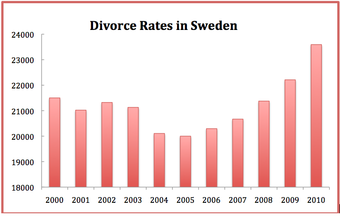
Divorce Rates in Sweeden
This graph depicts divorce rates in Sweden from 2000 to 2010.
12.5.2: Child Custody Laws
Child custody laws describe the legal and practical relationship between a parent and his or her child.
Learning Objective
Contrast different types of custody
Key Points
- Physical custody involves the day-to-day care of a child and establishes where a child will live.
- If a child lives with both parents, each parent shares “joint physical custody” and each parent is said to be a “custodial parent”.
- Shared custody is an arrangement in which the child lives for an extended period of time with one parent and then for a similar amount of time with the other parent.
- Alternating custody is an arrangement in which the child lives for an extended period of time with one parent and then for a similar amount of time with the other parent.
- A custodial parent is a parent who is given physical and/or legal custody of a child by court order.
- A non-custodial parent is a parent who does not have physical and/or legal custody of his/her child by court order.
- In Troxel v. Granville (2000), the U.S. Supreme Court affirmed that a biological parent holds a fundamental right in choosing how to raise one’s children as they see fit.
Key Terms
- Parenting Schedule
-
A schedule of which divorced parent is responsible for the child at any given point in time.
- Troxel v. Granville
-
A U.S. Supreme Court case (2000) that affirmed that a biological parent holds a fundamental right in choosing how to raise one’s children as they see fit.
Child custody and guardianship are legal terms, which are used to describe the legal and practical relationship between a parent and his or her child, such as the right of the parent to make decisions for the child, and the parent’s duty to care for the child. Following ratification of the United Nations Convention on the Rights of the Child in most countries, terms such as “residence” and “contact” have superseded the concepts of “custody” and “access. ” Instead of a parent having “custody” of or “access” to a child, a child is now said to “reside” or have “contact” with a parent. For a discussion of the new international nomenclature, see “parental responsibility. “
Residence and contact issues typically arise in proceedings involving divorce, annulment, and other legal proceedings where children may be involved. In most jurisdictions the issue of which parent the child will reside with is determined in accordance with the best interests of the child standard. Family law proceedings which involve issues of residence and contact often generate the most acrimonious disputes. While most parents cooperate when it comes to sharing their children and resort to mediation to settle a dispute, not all do. For those that engage in litigation, there seem to be few limits.
Types of Custody
Under family law, there are different types of custody. Alternating custody is an arrangement whereby the child lives for an extended period of time with one parent, and then for a similar amount of time with the other parent. While the child is with the parent, that parent retains sole authority over the child. Further, shared custody is an arrangement whereby the child lives for an extended period of time with one parent, and then for a similar amount of time with the other parent. Physical custody involves the day-to-day care of a child, and establishes where a child will live. A parent with physical custody has the right to have his/her child live with him/her. If a child lives with both parents, each parent shares “joint physical custody” and each parent is said to be a “custodial parent. ” Thus, in joint physical custody, neither parent is said to be a “non-custodial parent. “
Custodial and Non-Custodial Parents
A custodial parent is a parent who is given physical and/or legal custody of a child by court order. A child-custody determination means a judgment, decree, or other order of a court providing for the legal custody, physical custody, or visitation with respect to a child. The term includes a permanent, temporary, initial, and modification order. The term does not include an order relating to child support or other monetary obligation of an individual. A non-custodial parent is a parent who does not have physical and/or legal custody of his/her child by court order.
Child Custody Laws in the United States
In Troxel v. Granville (2000), the U.S. Supreme Court affirmed that a biological parent holds a fundamental right in choosing how to raise one’s children as they see fit. Later in the case of O’Donnell-Lamont (2004), the court affirmed an Oregon statute requiring a presumption that the parent acts in the child’s best interests, to be met prior to applying the best interests of the child standard, placing both parties on equal footing.
A New Terminology?
In some places, courts and legal professionals are beginning to use the term “parenting schedule” instead of “custody and visitation. ” The new terminology eliminates the distinction between custodial and noncustodial parents and also attempts to build upon the best interests of the children by crafting schedules that meet the developmental needs of the children. For example, younger children need shorter, more frequent time with parents, whereas older children and teenagers may demand less frequent shifts yet longer blocks of time with each parent.
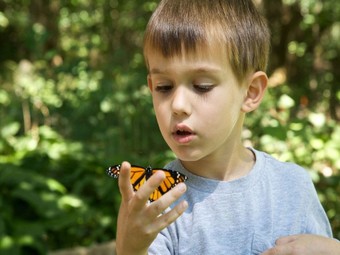
Child Custody
Residence and contact issues typically arise in proceedings involving divorce, annulment and other legal proceedings where children may be involved.In most jurisdictions the issue of which parent the child will reside with is determined in accordance with the best interests of the child.
12.5.3: Statistical Trends in Divorce
Divorce statistics vary across the world, but on average, first marriages that end in divorce last about eight years.
Learning Objective
Name three important statistical trends in divorce in the U.S.
Key Points
- Success in marriage has been associated with higher education and higher age.
- The growth of divorce rates in the United States have been dropping during the last few decades.
- One study estimated that legal reforms accounted for about 20% of the increase in divorce rates in Europe between 1960 and 2002.
Key Term
- Divorce Statistics
-
Quantitative measures of marriage and marital dissolution.
Examples
- Of the first marriages for women from 1955 to 1959, about 79% marked their 15th anniversary, compared with only 57% for women who married for the first time from 1985 to 1989.
- A 2011 study found a 1% increase in the unemployment rate correlated with a 1% decrease in the divorce rate, presumably because more people were financially challenged to afford the legal proceedings.
- In 2009 in the United States, 2.9% of adults 35–39 without a college degree were divorced, compared with 1.6% with a college education.
Divorce statistics vary across the world. On average, first marriages that end in divorce last about eight years. Of the first marriages for women from 1955 to 1959, about 79% marked their 15th anniversary, compared with only 57% for women who married for the first time from 1985 to 1989. The median time between divorce and a second marriage was about three and a half years.
Successful Marriages
Success in marriage has been associated with higher education and higher age. 81% of college graduates, over 26 years of age, who wed in the 1980’s, were still married 20 years later. 65% of college graduates under 26, who married in the 1980’s, were still married 20 years later. 49% of high school graduates under 26 years old, who married in the 1980’s, were still married 20 years later. Population studies have found that in 2004 and 2008, liberal-voting states have lower rates of divorce than conservative-voting states, possibly because people in liberal states tend to wait longer before getting married. In 2009, 2.9% of adults 35–39 without a college degree were divorced, compared with 1.6% with a college education.
Divorce in the United States
Divorce rates in the United States have been dropping during the last few decades. Data indicates that marriages have lasted longer in the 21st century than they did in the 1990’s. The National Center for Health Statistics reports that from 1975 to 1988, in families with children present, wives file for divorce in approximately two-thirds of cases. In 1975, 71.4% of the cases were filed by women, and in 1988, 65% were filed by women. It is estimated that upwards of 95% of divorces in the U.S. are “uncontested,” because the two parties are able to come to an agreement without a hearing about the property, children, and support issues. A 2011 study found a 1% increase in the unemployment rate correlated with a 1% decrease in the divorce rate, presumably because more people were financially challenged to afford the legal proceedings.
Divorce around the World
One study estimated that legal reforms accounted for about 20% of the increase in divorce rates in Europe between 1960 and 2002. In Australia, nearly every third marriage ends in divorce. After reaching a peak divorce rate of 2.7 per 1,000 residents in 2001, the Australian rate declined to 2.3 per 1,000 in 2007. In Japan, divorces were on a generally upward trend from the 1960’s until 2002 when they hit a peak of 290,000. Since then, both the number of divorces and the divorce rate have declined for six years straight.
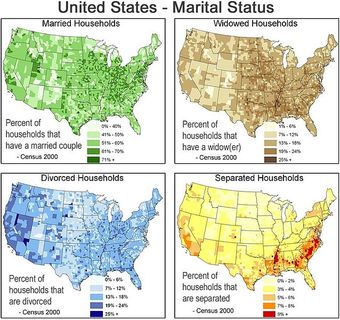
Marital Status in the United States Chart
This image depicts marital status in the U.S.
12.5.4: Factors Associated with Divorce
Factors that may lead marriages to end in divorce are infidelity, adultery domestic violence, midlife crises, inexperience, and addictions.
Learning Objective
Discuss five factors that may lead marriages to end in divorce
Key Points
- Adultery is voluntary sexual intercourse between a married person and someone other than the lawful spouse.
- Infidelity most commonly refers to a breach of the expectation of sexual exclusivity that is expressed or implied in intimate relationships in many cultures.
- Domestic violence is defined as a pattern of abusive behaviors by one partner against another in an intimate relationship such as marriage.
- A midlife crisis is a term that was coined by Elliott Jaques in 1965 that suggests it is a time when adults come to realize their own mortality and how much time is left in their lives, prompting a sudden change in behavior.
- Alcoholism is a broad term for problems with alcohol and is generally used to mean compulsive and uncontrolled consumption of alcoholic beverages
- Problem gambling is an urge to continuously gamble despite harmful negative consequences or a desire to stop.
Key Terms
- infidelity
-
Unfaithfulness in marriage or other moral obligation.
- Midlife Crisis
-
A term coined by Elliott Jaques in 1965 that suggests it is a time when adults come to realize their own mortality and how much time is left in their lives, prompting a sudden change in behavior
- domestic violence
-
Violence against another in an intimate relationship such as marriage or domestic partnership.
Numerous studies have tried to determine why 50 percent of marriages in the United States end in divorce within the first 25 years. While not conclusive, the predominate factors that lead marriages to end in divorce are infidelity, adultery domestic violence, midlife crises, inexperience, and addictions such as alcoholism and gambling.
Causes of Divorce
Adultery
Adultery is voluntary sexual intercourse between a married person and someone other than the lawful spouse. Historically, adultery has been considered a serious offense in many cultures. Even in jurisdictions where adultery is not a criminal offense itself, it may still have legal consequences, particularly in divorce cases.
Infidelity
More narrowly, infidelity most commonly refers to a breach of the expectation of sexual exclusivity that is expressed or implied in intimate relationships in many cultures.
Domestic Violence
Domestic violence is defined as a pattern of abusive behaviors by one partner against another in an intimate relationship such as marriage or domestic partnership.
Midlife Crisis
A midlife crisis is a term that was coined by Elliott Jaques in 1965 that suggests it is a time when adults come to realize their own mortality and how much time is left in their lives. A midlife crisis is experienced by many people during the midlife transition when they realize that life may be more than halfway over, prompting a sudden change in behavior.
Marrying Too Young
The age at which a person gets married is also believed to influence the likelihood of divorce. Delaying marriage until one is older or more experienced may provide more opportunity to choose a more compatible partner
Addictions
Alcoholism is a broad term for problems with alcohol, and is generally used to mean compulsive and uncontrolled consumption of alcoholic beverages, usually to the detriment of the drinker’s health, personal relationships, and social standing. Problem gambling is an urge to continuously gamble despite harmful negative consequences or a desire to stop. Problem gambling often is defined by whether harm is experienced by the gambler or others, rather than by the gambler’s behavior.
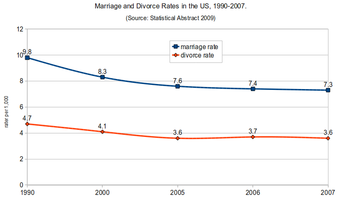
Marriage and Divorce Rates in the U.S. 1990-2007
This graph illustrates marriage and divorce rates in the U.S. 1990-2007. Source: Statistical Abstract, 2009.
12.5.5: Children of Divorce and Impact of Divorce
Sociologists and psychologists have found that the effects of divorce heavily depend on the child’s age at the time the divorce occurs.
Learning Objective
Compare and contrast the effects of divorce on infants and adolescents
Key Points
- Although infants may not understand the exact conflict, they do react to the difference in their parents’ mood and energy change.
- Pre-school aged children often mistake the divorce as their own fault.
- School-aged children have more of a difficult time adjusting to the parental divorce than younger or older children.
- Teens experience some of the same feelings as school-aged children. They feel anger, fear, depression, loneliness, and guilt.
- Sociologists believe that the rise in the number of older Americans who are not married is a result of factors such as longevity and economics.
- Elder women are becoming more and more financially independent which allows them to feel more secure with being alone.
Key Term
- longevity
-
The quality of being long-lasting, especially of life.
Example
- Children of divorced parents are reported to have a higher chance of behavioral problems than those of non-divorced parents. Studies have also reported the former are more likely to suffer abuse than children in intact families and have a greater chance of living in poverty.
Sociologists and psychologists have conducted research that shows the effects of divorce heavily depend on the child’s age at the time the divorce occurs. The child’s gender, personality, the amount of conflicts with the parents, and support of family and friends all contribute to the effects of divorce on a child.
Infants and Pre-School Children
Although infants may not understand the exact conflict, they do react to the difference in their parent’s mood and energy change. Some effects an infant may have include a loss of appetite and an increase in spit up. Pre-school children range from three to five years old and may often mistake the divorce as their own fault. Some of the effects for children at this age may include baby-like behavior such as old toys, a baby blanket, or even wetting the bed. They also may become depressed, uncooperative, or angry.
School-Aged Children and Adolescents
Children at this age have more of a difficult time adjusting to the parental divorce than younger or older children. At this age, children are able to understand the pain they feel due to the separation of their parents, but they are too young to control how they respond to the pain. Often children experience feelings of anger, grief, and embarrassment. In order to deal with the situation and cope, it is important that children become involved in activities with other kids. It is very common for children this age to hope that parents will eventually get back together.
Teens experience some of the same feelings as school-aged children. They feel anger, fear, depression, loneliness, and guilt. Some teens feel as though they must take on new responsibilities such as new chores and taking care of siblings. Teens may also doubt his or her ability to get married or stay married.
Children of divorced parents (those entirely from unhappy families) are reported to have a higher chance of behavioral problems than those of non-divorced parents (a mix of happy and unhappy families). Studies have also reported the former to be more likely to suffer abuse than children in intact families, and to have a greater chance of living in poverty. A 2002 article in Clinical Child and Family Psychology Review discusses a variety of health consequences for children of the unhappy couples that do divorce. Constance Ahron, who has published books suggesting there may be positive effects for children, interviewed ninety-eight divorced families’ children for We’re Still Family: What Grown Children Have to Say About Their Parents’ Divorce. Data from this study, in which she describes the binuclear family, is available at the Harvard Library and online.
Although divorce may be beneficial in some instances, high-conflict divorce (especially during transition periods) is harmful to children. Children who are shuffled back and forth between households, and those who hear their parents bickering and fighting, are likely to suffer the most. The best practice to avoid problems for children is to spend more or equal time with them while minimizing the amount of transitions for the children.
Divorced and Unmarried Elderly
Sociologists believe that the rise in the number of older Americans who are not married is a result of factors such as longevity and economics. Women, especially, are becoming more and more financially independent which allows them to feel more secure with being alone. In previous generations, being divorced or single was seen differently than it is now. This has resulted in less pressure for baby boomers to marry or stay married. Demographers estimate that baby boomers who remain unmarried will face more financial struggles than those who are married.
12.5.6: The Absent Father and Serial Fatherhood
Involved fathers contribute to their children’s development.
Learning Objective
Contrast the role of fathers in different cultures
Key Points
- According to the anthropologist Maurice Godelier, the parental role assumed by human males is a critical difference between human society and that of humans’ closest biological relatives—chimpanzees and bonobos—who appear to be unaware of their “father” connection.
- Stepfathers are males married to biological mothers of children whom they did not create.
- The father complex in psychology is a complex pertaining to a group of unconscious associations, or strong unconscious impulses, which specifically pertain to the image or archetype of the father. These impulses may be either positive or negative.
Key Terms
- Father Complex
-
A complex pertaining to a group of unconscious associations, or strong unconscious impulses, which specifically pertain to the image or archetype of the father.
- Maurice Godelier
-
An anthropologist who studies the differences in fatherhood between humans and apes.
A father is defined as a male parent or individual progenitor of human offspring. The adjective “paternal” refers to a father and comparatively to “maternal” for a mother. Traditionally, fathers act in a protective, supportive and responsible way toward their children. Involved fathers offer developmentally specific provisions to their sons and daughters throughout the life cycle, and are impacted themselves by doing so. According to the anthropologist Maurice Godelier, the parental role assumed by human males is a critical difference between human society and that of humans’ closest biological relatives—chimpanzees and bonobos—who appear to be unaware of their “father” connection.
In many cultures, especially traditional Western, a father is usually the husband in a married couple. Many times, fathers have a very important role in raising offspring, and the title can be given to a non-biological father that fills this role. This is common in stepfathers, or males married to biological mothers. In East Asian and Western traditional families, fathers are the heads of the families, which means that their duties include providing financial support and making critical decisions, some of which must be obeyed without question by the rest of the family members.
The Father complex in psychology is a complex pertaining to a group of unconscious associations, or strong unconscious impulses, which specifically pertain to the image or archetype of the father. These impulses may be either positive or negative. Whereas the idea of the father complex had originally evolved to deal with the heavy Victorian patriarch, by the new millennium there had developed instead a postmodern preoccupation with the loss of paternal authority, or the absence of the father. Alongside the shift from a Freudian emphasis on the role of the father to object relations theory’s stress upon the mother, psychoanalysis tended to single out the search for the father, and the negative effects of the switched-off father.

Father
Many fathers are married to the biological mothers of their children.
12.6: Family Violence
12.6.1: Family Violence
Family violence is defined as a pattern of abusive behaviors by one family member against another.
Learning Objective
Discuss the various types of domestic violence, such as physical or economic, as well as the effects on all people involved
Key Points
- Physical abuse is abuse involving contact intended to cause feelings of intimidation, pain, injury, or other physical suffering or bodily harm.
- Sexual abuse is any situation in which force or threat is used to obtain participation in unwanted sexual activity.
- Verbal abuse is a form of emotionally abusive behavior involving the use of language.
- Economic abuse is a form of abuse when one intimate partner has control over the other partner’s access to economic resources.
Key Terms
- Verbal Abuse
-
A form of emotionally abusive behavior involving the use of language.
- Economic Abuse
-
When one intimate partner has control over the other partner’s access to economic resources.
- domestic violence
-
Violence against another in an intimate relationship such as marriage or domestic partnership.
Examples
- Coercing a person to engage in sexual activity against his or her will, even if that person is a spouse or intimate partner with whom consensual sex has occurred, is an act of aggression and violence.
- Coercing a person to engage in sexual activity against their will, even if that person is a spouse or intimate partner with whom consensual sex has occurred, is an act of aggression and violence.
- 3.3 million children witness domestic violence each year in the US.
Domestic violence is defined as a pattern of abusive behaviors by one partner against another in an intimate relationship such as marriage, dating, family, or cohabitation. In this definition, domestic violence takes many forms, including physical aggression or assault, sexual abuse, emotional abuse, controlling or domineering behaviour, intimidation, stalking, passive/covert abuse, and economic deprivation. Alcohol consumption and mental illness can be co-morbid with abuse, presenting additional challenges in eliminating domestic violence. In general, awareness, perception, definition, and documentation of domestic violence differ widely from country to country, and from era to era.
Forms of Domestic Violence
All forms of domestic abuse have one purpose: to gain and maintain control over the victim. Abusers use many tactics to exert power over their spouse or partner: dominance, humiliation, isolation, threats, intimidation, denial, and blame. Physical abuse is abuse involving contact intended to cause feelings of intimidation, pain, injury, or other physical suffering or bodily harm. Physical abuse includes hitting, slapping, punching, choking, pushing, burning, and other types of contact that result in physical injury to the victim. Physical abuse can also include behaviors such as denying the victim of medical care when needed, depriving the victim of sleep or other functions necessary to live, or forcing the victim to engage in drug/alcohol use against his/her will. Sexual abuse is any situation in which force or threat is used to obtain participation in unwanted sexual activity. Coercing a person to engage in sexual activity against his or her will, even if that person is a spouse or intimate partner with whom consensual sex has occurred, is an act of aggression and violence.
Emotional abuse can include humiliating the victim privately or publicly, controlling what the victim can and cannot do, withholding information from the victim, deliberately doing something to make the victim feel diminished or embarrassed, isolating the victim from friends and family, implicitly blackmailing the victim by harming others when the victim expresses independence or happiness, or denying the victim access to money or other basic resources and necessities. Degradation in any form can be considered psychological abuse.
Verbal abuse is a form of emotionally abusive behavior involving the use of language. Verbal abuse can also be referred to as the act of threatening. Through threatening a person can blatantly say they will harm you in any way and will also be considered as abuse.
Economic abuse is a form of abuse when one intimate partner has control over the other partner’s access to economic resources. Economic abuse may involve preventing a spouse from resource acquisition, limiting the amount of resources to use by the victim, or by exploiting economic resources of the victim.
Effects of Domestic Abuse
3.3 million children witness domestic violence each year in the US. There has been an increase in acknowledgment that children exposed to domestic abuse during their upbringing will suffer in their developmental and psychological welfare. Because of the awareness of domestic violence that some children have to face, it also generally impacts how the child develops emotionally, socially, behaviorally as well as cognitively. Some emotional and behavioral problems that can result due to domestic violence include increased aggressiveness, anxiety, and changes in how a child socializes with friends, family, and authorities. Bruises, broken bones, head injuries, lacerations, and internal bleeding are some of the acute effects of a domestic violence incident that require medical attention and hospitalization.
High amounts of stress, fear, and anxiety are commonly reported by victims still living with their perpetrators. These are known as the psychological effects of domestic violence. Depression is also common, as victims are made to feel guilty for ‘provoking’ the abuse and are frequently subjected to intense criticism. A reported 60 percent of victims meet the diagnostic criteria for depression, either during or after termination of the relationship, and have a greatly increased risk of suicide. Once victims leave their perpetrator, they can be stunned with the reality of the extent to which the abuse has taken away their autonomy. Due to economic abuse and isolation, victims usually have very little money of their own and few people on whom they can rely when seeking help. These are the financial effects of domestic violence. This has been shown to be one of the greatest obstacles facing victims of DV, discouraging them from leaving their abusers.

Family Violence
Kalighat Painting, “Woman Striking Man With Broom,” Calcutta, India, 1875.
12.6.2: Child Abuse
Child abuse is the physical, sexual or emotional mistreatment, or neglect of a child.
Learning Objective
Analyze the differences between and prevalence of each type of abuse against children
Key Points
- Physical abuse involves physical aggression directed at a child by an adult.
- Child sexual abuse is a form of child abuse in which an adult or older adolescent abuses a child for sexual stimulation.
- Neglect is a passive form of abuse in which a perpetrator is responsible to provide care for a victim who is unable to care for himself or herself, but fails to provide adequate care.
- Emotional abuse includes things such as name-calling, ridicule, degradation, destruction of personal belongings, torture or killing of a pet, etc.
Key Terms
- Child Sexual Abuse
-
A form of child abuse in which an adult or older adolescent abuses a child for sexual stimulation.
- child abuse
-
The physical, sexual, or emotional mistreatment of a child.
Examples
- In the U.S., neglect is defined as the failure to meet the basic needs of children: housing, clothing, food, and access to medical care. Researchers found over 91,000 cases of neglect in one year using information from a database of cases verified by protective services agencies.
- Approximately 15% to 25% of women and 5% to 15% of men were sexually abused when they were children.
Child abuse is the physical, sexual, or emotional mistreatment or neglect of a child or children. Different jurisdictions have developed their own definitions of what constitutes child abuse for the purposes of removing a child from his/her family and/or prosecuting a criminal charge. There are four major categories of child abuse: neglect, physical abuse, psychological/emotional abuse, and sexual abuse. Neglect is the most common type of abuse in the United States and accounts for over 60 percent of child abuse cases.
Physical Abuse
Physical abuse involves physical aggression directed at a child by an adult. Most nations with child-abuse laws consider the deliberate infliction of serious injuries, or actions that place the child at obvious risk of serious injury or death, to be illegal. Beyond this, there is considerable variation. The distinction between child discipline and abuse is often poorly defined. Cultural norms about what constitutes abuse vary widely among professionals as well as the wider public. Some professionals claim that cultural norms that sanction physical punishment are one of the causes of child abuse, and have undertaken campaigns to redefine such norms.
Sexual Abuse
Child sexual abuse is a form of child abuse in which an adult or older adolescent abuses a child for sexual stimulation. Effects of child sexual abuse include guilt and self-blame, flashbacks, nightmares, insomnia, and fear of things associated with the abuse. Approximately 15 percent to 25 percent of women and 5 percent to 15 percent of men were sexually abused when they were children.
Emotional Abuse
Out of all the possible forms of abuse, emotional abuse is the hardest to define. It could include name-calling, ridicule, degradation, destruction of personal belongings, torture or killing of a pet, excessive criticism, inappropriate or excessive demands, withholding communication, and routine labeling or humiliation.
Neglect
Neglect is a passive form of abuse in which a perpetrator is responsible to provide care for a victim who is unable to care for himself or herself, but fails to provide adequate care. Neglect may include the failure to provide sufficient supervision, nourishment, or medical care, or the failure to fulfill other needs for which the victim is helpless to provide for himself or herself. The term is also applied when necessary care is withheld by those responsible for providing it from animals, plants, and even inanimate objects. Neglect can have many long-term side effects, such as physical injuries, low self-esteem, attention disorders, violent behavior, and even death. In the U.S., neglect is defined as the failure to meet the basic needs of children: housing, clothing, food, and access to medical care. Researchers found over 91,000 cases of neglect in one year using information from a database of cases verified by protective services agencies.
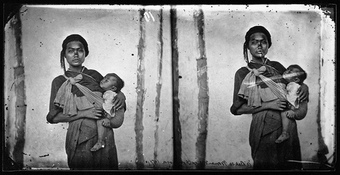
Child Abuse
Child abuse is the physical, sexual or emotional mistreatment, or neglect of a child.
12.6.3: Spousal Abuse
Spousal abuse can be defined as a pattern of abusive behaviors by one or both partners in an intimate relationship.
Learning Objective
Evaluate the gender differences in domestic violence against both men and women in heterosexual and homosexual relationships
Key Points
- Determining how many instances of domestic violence actually involve male victims is difficult. Male domestic violence victims may be reluctant to get help for a number of reasons, including feeling ashamed because their victimhood negates their masculinity.
- Gender roles and expectations play a role in abusive situations.
- Domestic violence also occurs in same-sex relationships.
- Domestic violence also occurs in same-sex relationships.
Key Terms
- Violence against Women
-
Violence perpetrated against a female victim for reasons having to do with gender expectations.
- Violence against Men
-
Violence perpetrated against a male victim for reasons having to do with gender expectations.
Example
- According to a report by the United States Department of Justice, a survey of 16,000 Americans showed 22.1 percent of women and 7.4 percent of men reported being physically assaulted by a current or former spouse, cohabiting partner, boyfriend, girlfriend, or date in their lifetime.
The relationship between gender and domestic violence is a controversial topic. Debate revolves around the rates at which each gender is subjected to domestic violence and whether abused men should be provided the same resources and shelters that exist for female victims. Some studies suggest that men are less likely to report being victims of domestic violence due to social stigmas. Other sources argue that the rate of domestic violence against men is often inflated due to the practice of including self-defense as a form of domestic violence.
A problem in conducting studies that seek to describe violence in terms of gender is the amount of silence, fear, and shame that results from abuse within families and relationships. Another problem is that abusive patterns can tend to seem normal to those who have lived in them for a length of time. Similarly, subtle forms of abuse can be transparent even as they set the stage for normalizing further abuse. Finally, inconsistent definition of what constitutes domestic violence makes definite conclusions difficult to reach when compiling research.
Violence Against Women
Although the exact rates are widely disputed, especially within the United States, there is a large body of cross-cultural evidence that women are subjected to domestic violence significantly more often than men. In addition, there is broad consensus that women are more often subjected to severe forms of abuse and are more likely to be injured by an abusive partner. According to a report by the United States Department of Justice, a survey of 16,000 Americans showed 22.1 percent of women and 7.4 percent of men reported being physically assaulted by a current or former spouse, cohabiting partner, boyfriend, girlfriend, or date in their lifetime.
Violence Against Men
Determining how many instances of domestic violence actually involve male victims is difficult. Male domestic violence victims may be reluctant to get help for a number of reasons. Another study has demonstrated a high degree of acceptance by women of aggression against men. Some researchers have found a relationship between the availability of domestic violence services, improved laws and enforcement regarding domestic violence, increased access to divorce, and higher earnings for women with declines in intimate partner homicide by women.
Gender roles and expectations play a role in abusive situations, and exploring these roles and expectations can be helpful in addressing abusive situations. Likewise, it can be helpful to explore factors such as race, class, religion, sexuality, and philosophy. However, studies investigating whether sexist attitudes are correlated with domestic violence have shown conflicting results
Same-Sex Relationships
Domestic violence also occurs in same-sex relationships. Gay and lesbian relationships have been identified as a risk factor for abuse in certain populations. In an effort to be more inclusive, many organizations have made an effort to use gender-neutral terms when referring to the act of perpetrating and victimhood.
Historically, little interest has been directed at domestic violence in same-sex relationships. As the gay rights movement has brought gay and lesbian issues into public attention, more research has been conducted on same-sex relationships. A 1999 analysis of 19 different studies of partner abuse concluded that “lesbians and gay men are just as likely to abuse their partners as heterosexual men,” although the study also noted the uncertain nature of much of the contemporary research.

Spousal Violence in Same-sex Relationships
Domestic violence also occurs in same-sex relationships.
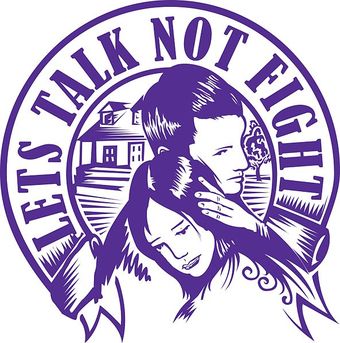
Let’s Talk, Not Fight
Colin Henderson’s winning design were displayed on T-shirts and other items at the 2012 Domestic Violence Awareness Rally.
